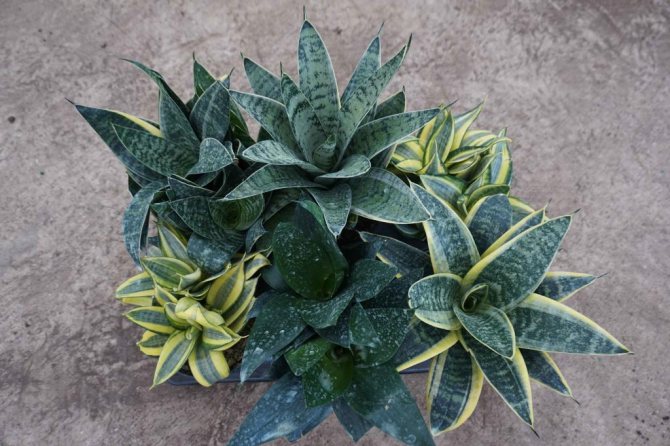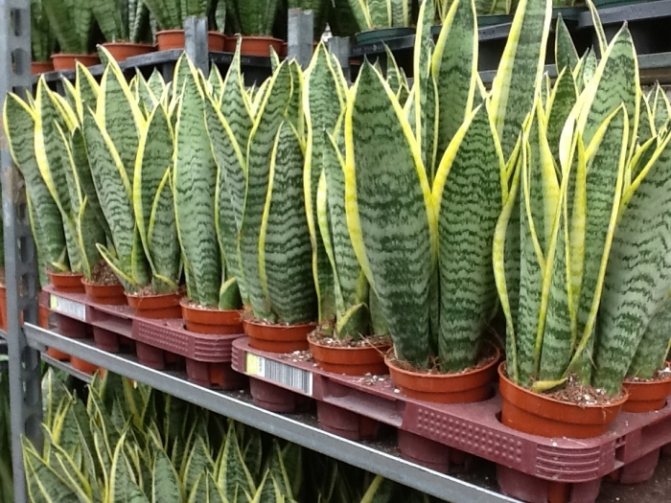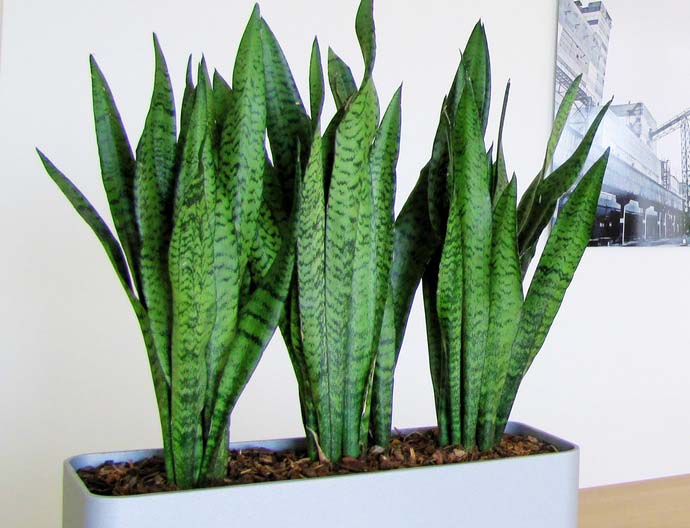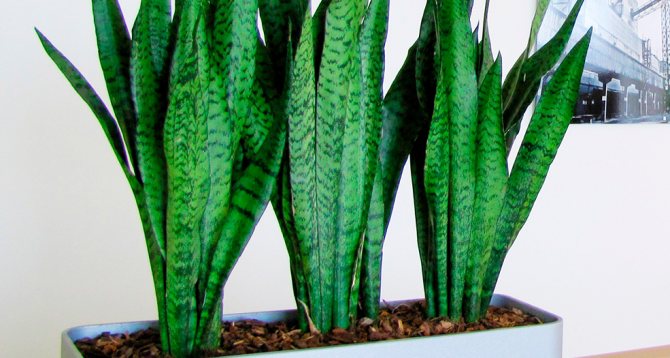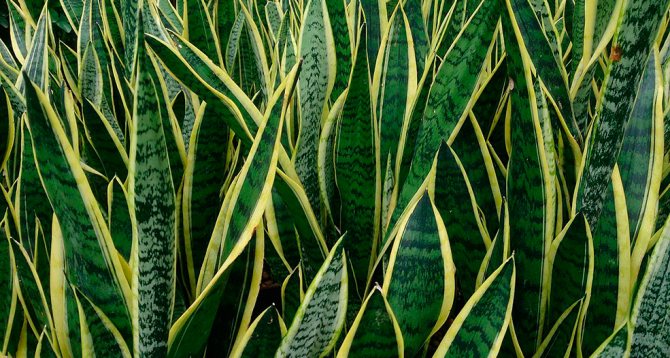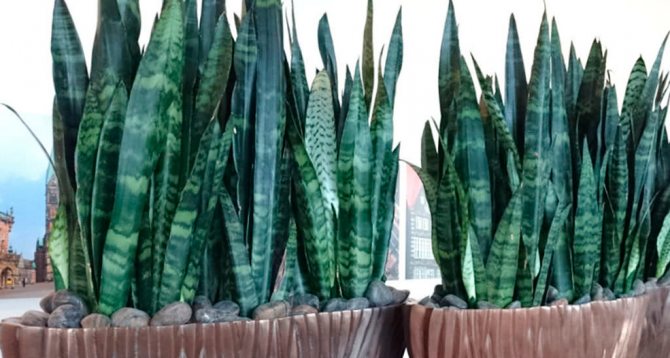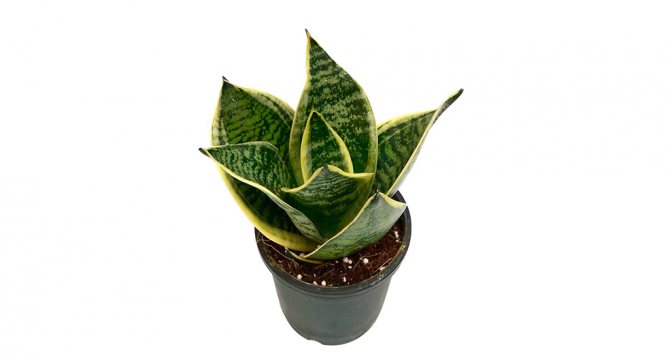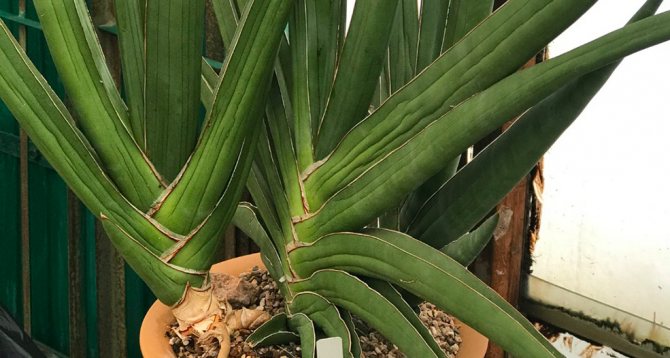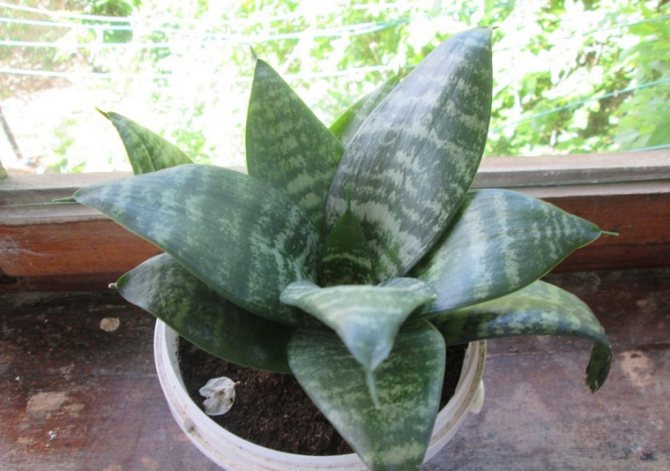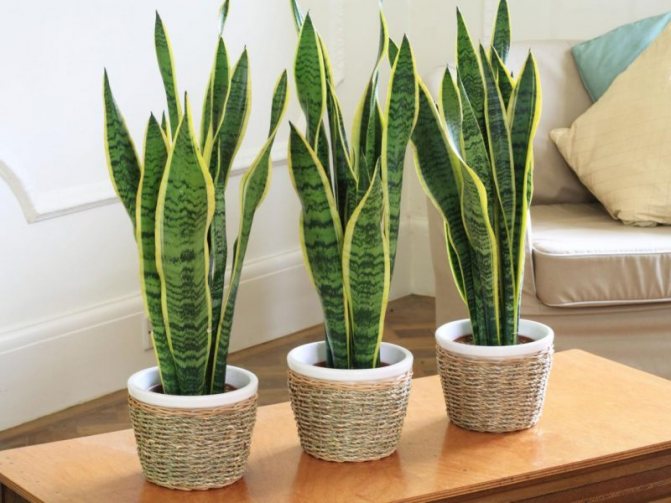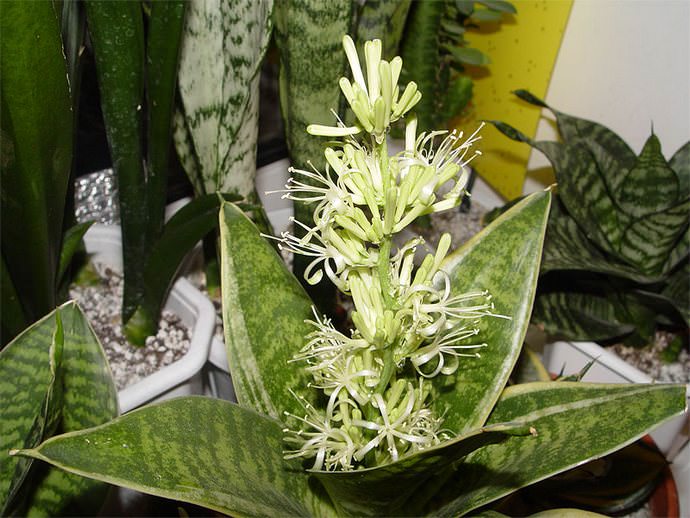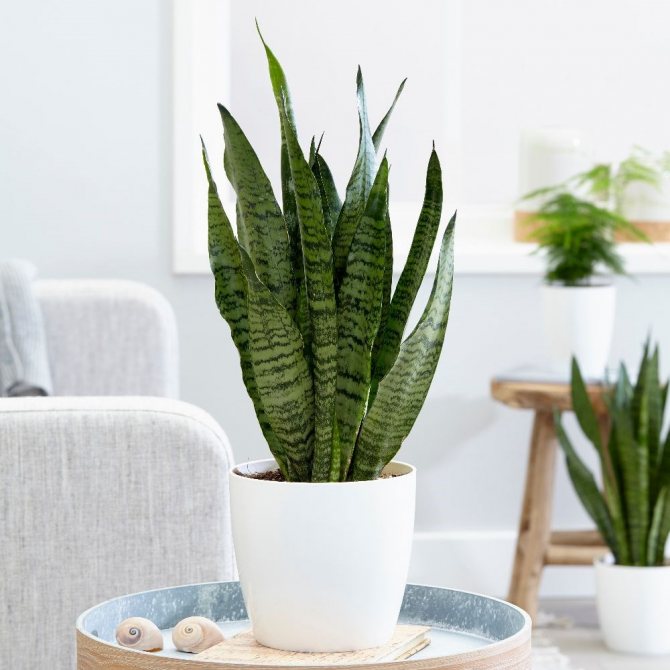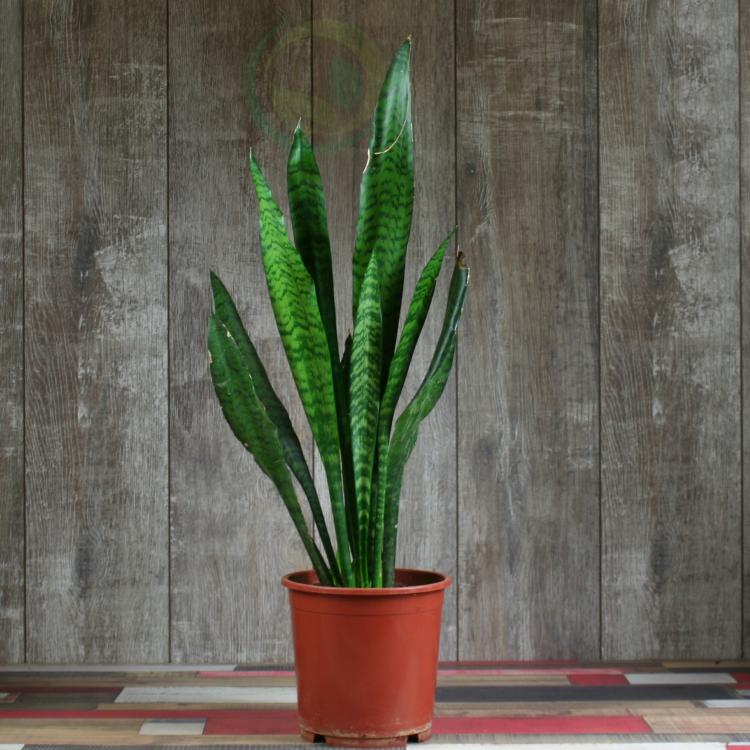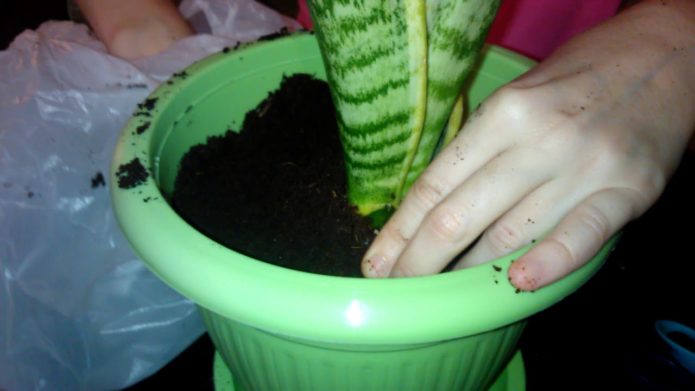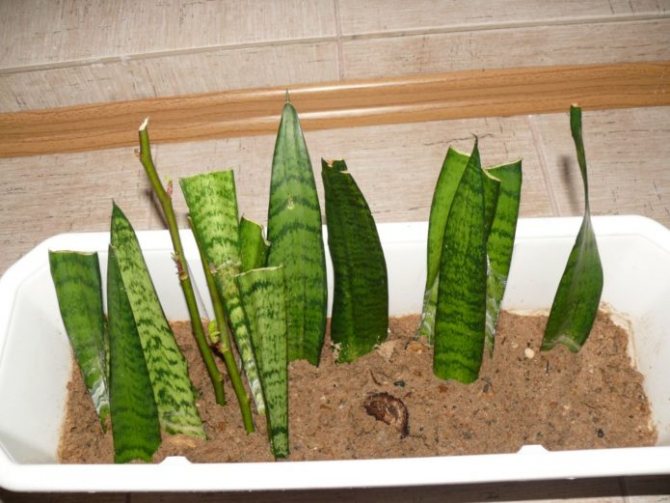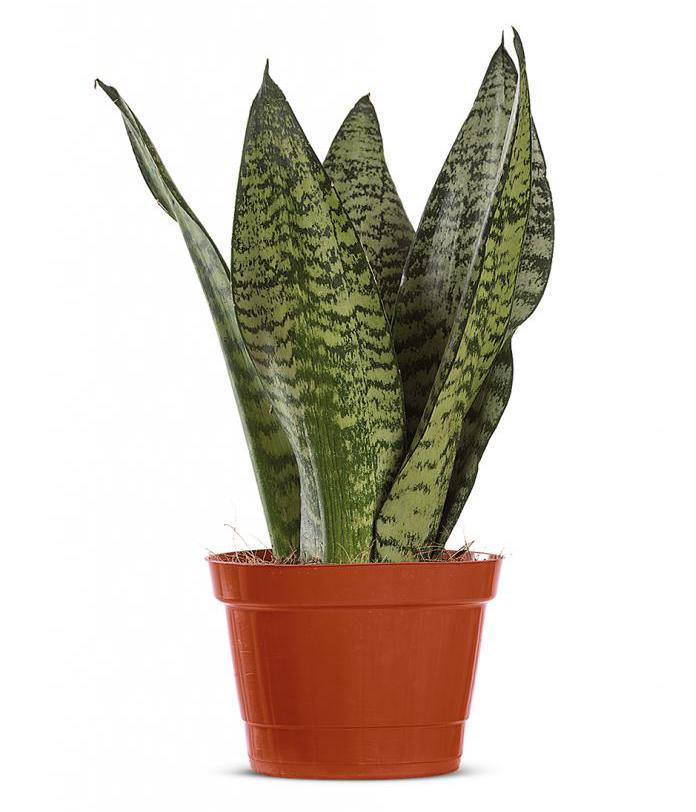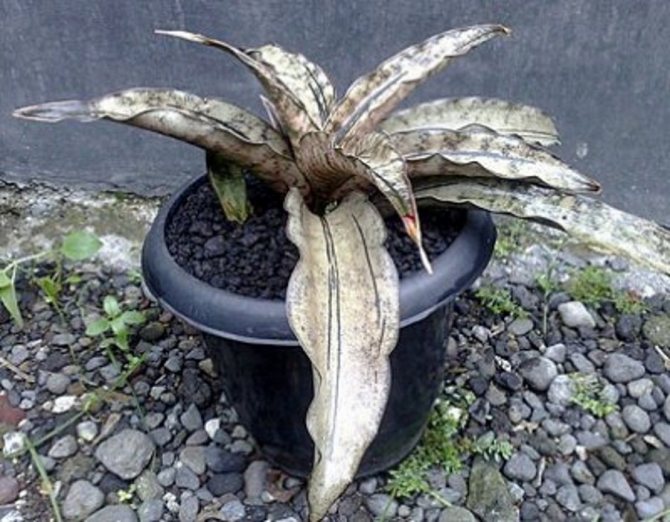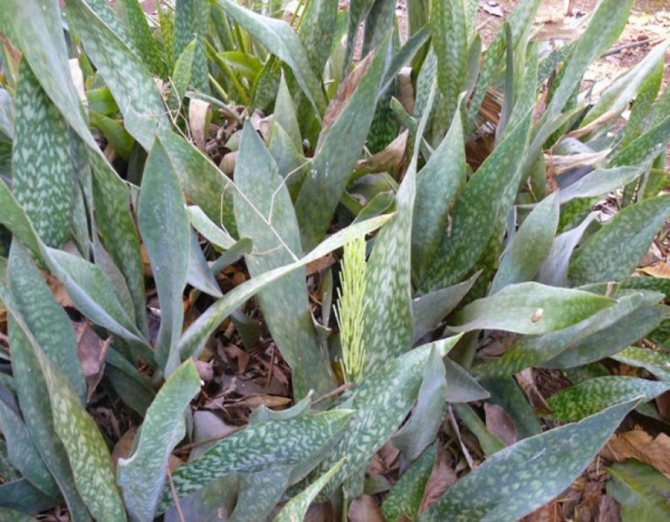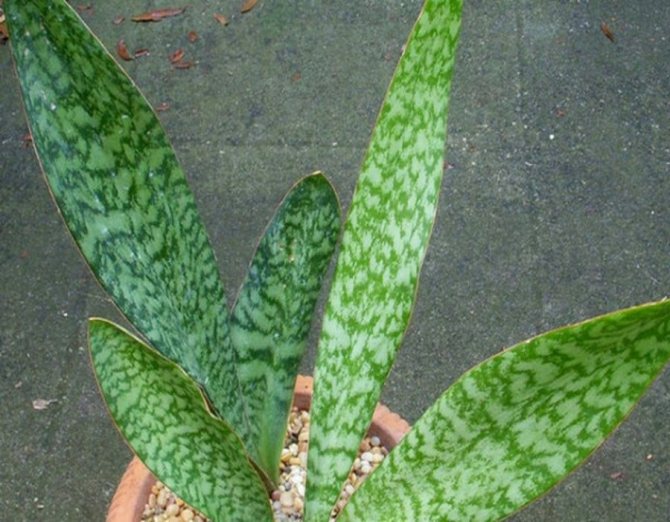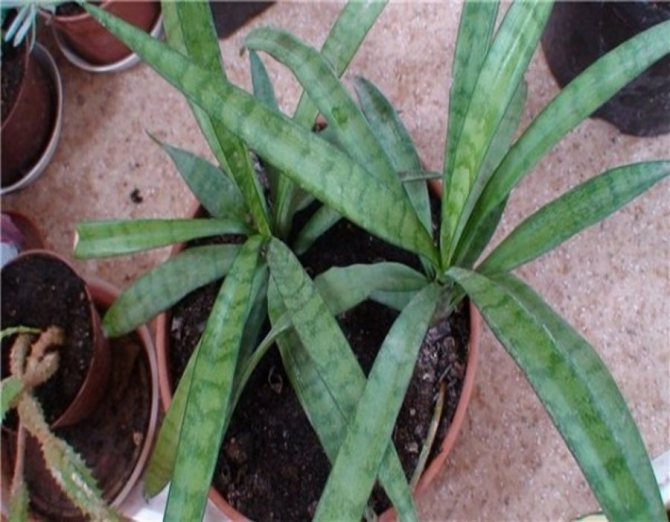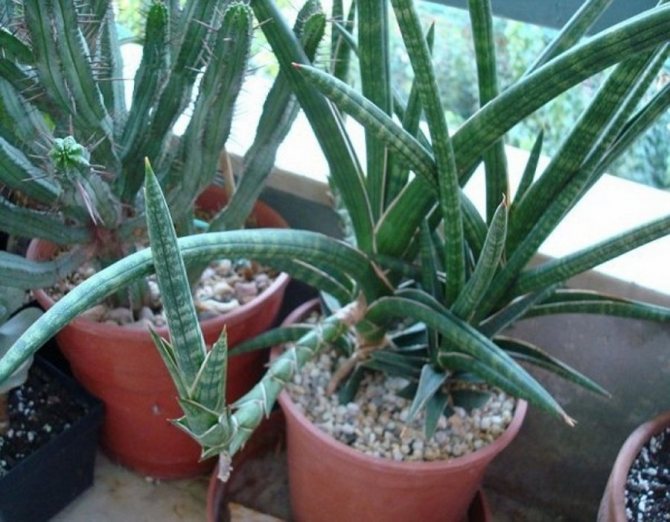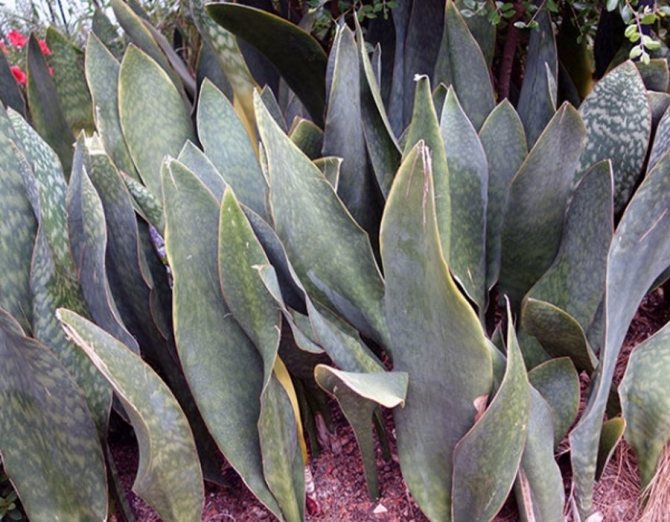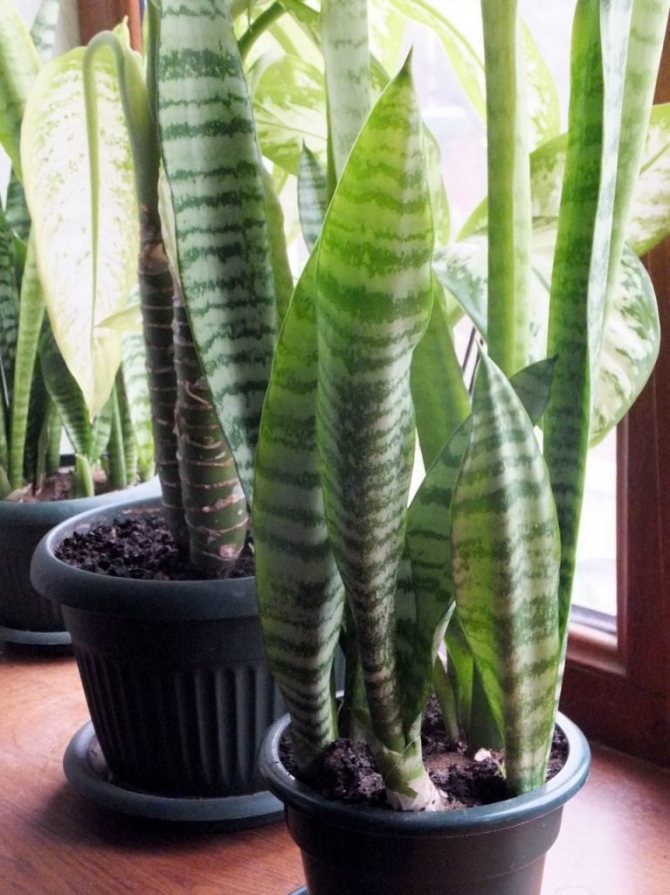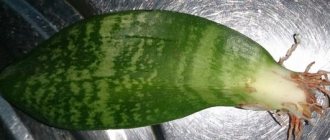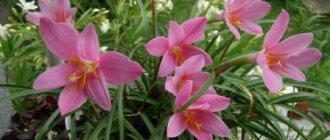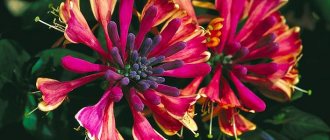A popular houseplant - the mother-in-law's tongue flower can often be found in apartments, offices and government offices. It has many popular names and associated beliefs and signs. The plant is easy to care for and grows well in different conditions.
Why "mother-in-law's language" can be dangerous for the family
While doing the renovation, I decided to save money on the interior designer by copying a picture from a magazine. That interior was Scandinavian - white walls, light furniture, and a few bright green accent spots. The picture showed large pots with sansevieria - a flowerpot popularly known as mother-in-law's tongue.
For the housewarming party, I also bought one (by the way, it turned out to be easy to find it, sansas are sold in many garden centers). But both my mother and mother-in-law, who saw the plant, as they conspired, immediately began to persuade me to get rid of the fashionable flower. Like, his place is only in the clinic, "abode of pain and resentment", and in the house he is strictly contraindicated to grow ...
How to activate the positive energy of the sanservier?
To get a healthy plant to run at full capacity, it needs to be placed in the right place. The best location for "mother-in-law" is a window sill in the kitchen, or a window overlooking the courtyard. In this way, you can protect yourself from the envy of passers-by, looking into your window.
Choosing a pot for such an important plant has its own subtleties:
- Red flowerpots should be avoided so as not to inflame passions at home or in the office.
- A pot of a calm gray, beige or blue shade will be successful.
- The metal elements of the flowerpot decor will also come in handy. After all, metal well cools the heat of passions.
It is very good if you got the flower "leopard lily" in a bad condition, but managed to get it out. The plant will surely thank its owner and bring good luck. If the leaves of the "mother-in-law's tongue" turn yellow - this is a harbinger of parting or a flower warns: the atmosphere in the family is bad, the case may end in troubles, health problems.
To "appease" the plant, wipe its leaves with a damp cloth, and talk to sansevieria like a person. It is customary to wish him good morning and good night, ask him how he is doing, share his positive emotions. It is possible that as a result of such communication with the green pet, troubles will recede, and "mother-in-law's language" will become a full member of the family. He will accumulate a solid share of positive emotions, and then generously share with you.
Signs and superstitions that envelop this pot
Fortunately, popular rumor is very supportive of the plant. And if one of your relatives decides to get rid of your beloved mother-in-law's tongue (or pike tail - as it is also called), just introduce him to the opinion of modern esotericists.

Positive
- Sansa protects the house from evil spirits, and is also a mental shield from negative energy entering our house from the outside... If the window on which sansa turns green overlooks the neighbour's windows and balconies, the flowerpot will also protect you from gossip coming to your family. Ideally, if the flowerpot is visible from the street.
- Flowerpot can bring good luck to your mistress or master.
- Plant pacifies hostility in the home, clearing the home from constant arguments and abuse. The fact is that the flowerpot is fueled by negative emotions, leaving the people around it one positive. In this regard, esotericists recommend: if sansa suddenly began to wither, put it near the TV, from which Malakhov often swears or news anchors tell negative facts. This will help the mother-in-law's tongue to improve its "mental health".
- Also after buying such a flowerpot in the house insincere, two-faced, people who are badly disposed towards the owners will become less likely to visit.
- It is also worth getting this flower for creative people. Long leaves, like antennas, will attract to them inspiration.
- It is best if your family got a flowerpot inherited... He will become a real family talisman and protection from many troubles.
- And if sansa bloomed, this is a sign: you can start a new business.


And in general, esotericists consider all plants, the leaves of which are constantly sticking up, to be the most favorable for the home.
But also at work keep mother-in-law's tongue well. For example, a flowerpot at the mental level will protect the table of the hostess (owner) from envious and overly picky colleagues.
Negative
- The blooming of the mother-in-law's tongue cannot but rejoice (especially since even experienced flower growers cannot always boast of blooming sansa). But if a flower appeared in winter - business is bad: quarrels, strife and sharp differences of opinion can begin in the house. Perhaps the cause of the squabbles will be someone's overprotection.
- If a flowerpot standing in the office blooms at this time of the year, this can also end in a scandal.
- There is also a belief that mother-in-law's tongue can not be started by newlyweds who have lived together for less than a year... They say that a plant can carry out a "strength test" of such a pair, and it does not matter in which room the pot with sansa is placed. If she ends up in the kitchen, it will cause domestic disputes, in the living room it will become a "magnet" for financial conflicts, and if you put a pot in the bedroom, the spouses can cool off to each other, or even treason will sneak into the family.
By the way! Feng Shui does not recommend putting sansa in the bedroom (near the bed) in any case and in any family. According to this doctrine, in a place where a person relaxes and is as defenseless as possible, one cannot hold sharp objects (vases with pointed leaves are also among them). It is better to immediately choose a place for the flower on the kitchen windowsill or in the living room.
- Also what matters is who gave you sansa... If a woman (especially a relative of her husband), the flowerpot will have a bad effect on the "weather in the house." And if this woman is young and unmarried, the gift can provoke adultery and even rupture of relations. It is also bad if the flowerpot is given by a widow (widower) or a person who is unhappy in family life.
- Important and pot color mother-in-law's tongue. Red, deep burgundy, or deep pink can help the plant heat up your home. Sansa is best planted in light pots (white, pastel or metallic colors - any hints of steel tend to reflect passion).


Important! If you decide not to have a mother-in-law tongue in your home, remember! It can be not only like this:
The superstitions listed above fully apply to all types of sansevieria.
The beneficial effects of the flower
Against the background of bad superstitions, there is an overwhelming majority of good omens about "mother-in-law". According to the Eastern teachings of Feng Shui, the vertically directed leaves of the domestic flower attract success, play the role of a "lightning rod" during family conflicts. Thus, the sanservier acts as an antenna that converts the absorbed negative into creative energy, liberates consciousness, stimulates the activity of thinking, and develops imagination.
Leopard Lily has practical benefits as an air purifier and medicinal plant. The action of the "mother-in-law's tongue" juice is similar to the healing ability of aloe pulp.Cut along the length of the "pike tail" can be applied to wounds, used to treat any skin damage, such as cuts, burns. An alcoholic tincture of sansevieria roots is useful for strengthening the immune system.
The magical effect of the "snake skin" flower:
- Harmonizes the situation in the family, literally helps to find a common language in desperate situations. For this purpose (contrary to negative superstitions) the plant should be presented by the parents of any of the spouses, and the flower should stand in the bedroom.
- Heals. The patient needs to stroke "mother-in-law's tongue" and ask for recovery. The disease will recede, the plant will take it over. To cure the baby, the baby's mother should stroke the "pike tail".
- Protects from damage and the evil eye. The plant should be kept where the owners communicate with the guests. Meetings will be held in a welcoming atmosphere, and people with bad intentions will stop visiting the house.
- Protects from unfair nagging. "Mother-in-law's tongue" must be put in the workplace. He will literally drive away enemies, help you focus on important matters.
- Helps to confess love. A person who received a sansevieria leaf as a gift should put it under the pillow and sleep on it for 3 nights.
Signs say that with the help of the "pike tail" unmarried young ladies can tell fortunes on their beloved. To do this, you need to choose a leaf of the plant, guess the name of the desired guy, and observe the marked leaf for a month. If the leaf develops well, does not wither, does not fall off, the young lady can count on reciprocity and love relationships with the chosen one.
If there is a deficit of happiness in the house, "storms" of a showdown are raging, you need to think about the neighborhood with the wonderful flower "mother-in-law's tongue". "Green Barometer" will be able to accurately predict the weather in the house. You need to put it in the room where the whole family spends the most time. Your life will change in the archery direction.
When is sansa useful?
- This is a quality air filter... Actually, this is why mother-in-law's language can be seen so often in schools and hospitals. But even in the house (especially if it is a one-room Khrushchev, in which a family of four lives), this green "pet" will also bring a lot of benefits. The plant ingests carbon dioxide, producing oxygen in return. By the way, the wider and greener the leaves of the plant, the more oxygen it releases.
- Traditional medicine lovers sometimes use sansa to preparation of natural medicinesthat help strengthen the immune system, cure inflammation or cystitis. But personally, I would recommend that you first get a "blessing" for the use of such funds from your therapist or a more narrow-profile doctor. After all, the composition of the leaves of the mother-in-law's tongue is very ambiguous ... Moreover, the plant has many contraindications - for example, it is prohibited for pregnant women.
When can a pike tail hurt?
If the flowerpot turns green peacefully on a shelf or windowsill, there will be no harm from it. It is worse if it is gnawed by a cat, a dog, or tasted by a small child. Mother-in-law's tongue - poisonous and highly toxic plant.
Once in the human body, sansa will not do much harm. The victim may experience pain in the mouth, nausea, and severe salivation.
Sometimes (rarely) cutting and grafting without gloves, in which sansevieria juice gets on the skin, can result in an allergic reaction.
As for the animals, they will have diarrhea, vomiting, and abdominal pain from such a "treat". Although at first it may be just profuse salivation and causeless anxiety.
Where is the best place to put
If a person believes in signs, the mother-in-law's tongue should be put in the living room. It is in this place that most often communication with guests occurs. The flower will help create a friendly atmosphere and save you from conflicts.If some of the guests have bad intentions, the pike tail will prevent damage to property.
In the marital bedroom, a pike tail should be placed in case of frequent quarrels and disagreements. However, this omen is effective only when the flower was donated by one of the spouses' parents.
Let's summarize


- Many believe that since the plant was called the mother-in-law language, it will attract gossip and controversy into the house. In fact, everything is just the opposite: the flowerpot normalizes the mental situation in the family, and the signs about it are almost all positive.
- The only bad omen associated with sansevieria is the bloom in winter. It promises quarrels and scandals.
- A plant can be really dangerous for a family if a baby has appeared in it (who crawls and pulls everything into his mouth) or a pet who loves to gnaw flowerpots lives. The fact is that the sap of the plant is poisonous and can greatly harm the body.
What other plants are more than just bright flowers or decorative foliage? I propose to learn about other indoor and garden flowers that can harm a person. Of course, this does not mean that you need to get rid of them immediately, but you need to grow, and even more so cut off, such flowers wisely:
Solution of problems
As a rule, pests bypass sansevieria - it is quite well protected from them. However, if the plant is weakened by improper care, sooner or later traditional pests of domestic flowers can reach it: spider mites, mealybugs or thrips. Therefore, you should know the signs of a deterioration in the health of the flower and how to eliminate the lesions.
Table: difficulties encountered in growing
| Problem | Cause | Decision |
| Leaves turn yellow at the base and die off | Waterlogged soil in winter |
|
| The neck rots with normal watering | Hypothermia | Raise the temperature of the content to an acceptable - 12 degrees and above. |
| Brown spots on the leaves, spreading from top to bottom | Disease of unknown nature | Remove affected leaves. |
Table: disease and pest control measures
| Pest | Signs of defeat | Preparations for processing plants | Control measures |
| Spider mite | On the leaves and between them, an airy web |
| To provide assistance, you must:
|
| Mealybug | White cotton-like bloom on leaves |
| The options are:
|
| Thrips | The appearance of unnatural discolored spots on leaves that are losing elasticity |
| The options are:
|
Photo gallery: insects that can appear on sansevieria
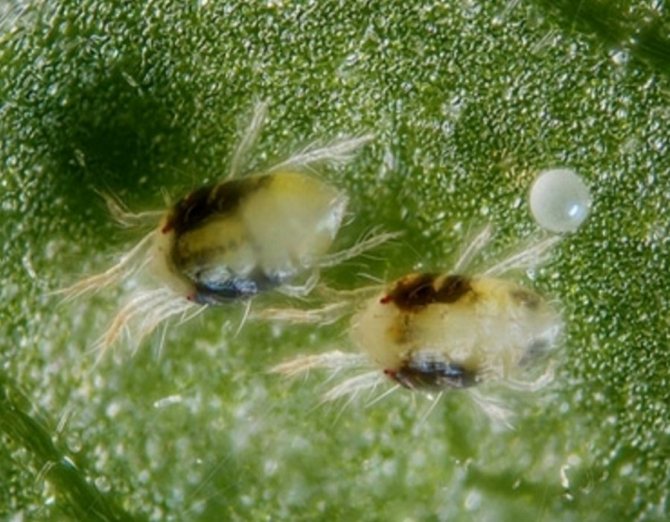

Spider mites appear from dry air


Mealybug starts up when waterlogged
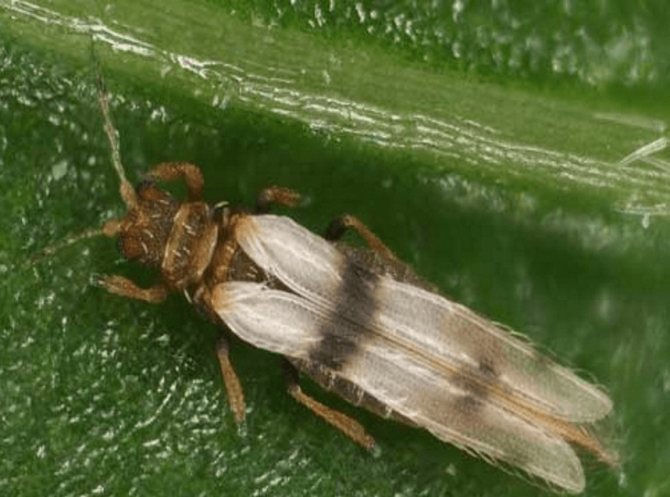

Thrips are usually brought into the house along with bouquets.
Mother-in-law tongue flower. Growing mother-in-law's tongue. Mother-in-law tongue care
Living in cities, people increasingly lose touch with nature.Many people strive to get out of the city as often as possible and spend time in nature. But they do not always have such an opportunity.
This is what contributes to the fact that indoor plants are becoming more in demand, and especially those that are able to treat any ailments. A striking representative of home flowers, which have certain healing abilities, is mother-in-law's tongue.
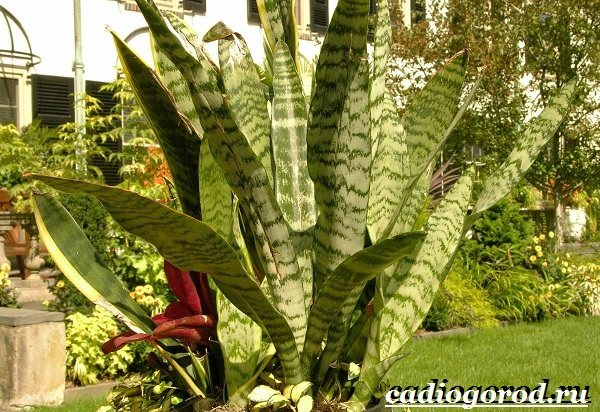

Description and features of the mother-in-law language
This extraordinary flower has many names among various peoples, but few people know its international name - sansevieria. The attitude to this flower is ambiguous and even a little mystical. According to omens flower mother-in-law tongue brings unhappiness to the house, however, all this is just superstition.
Post-flowering care
Does the plant need pruning after flowering?
As soon as the mother-in-law's tongue bloomed the peduncle must be cut off. And faded rosettes are used for plant propagation. Otherwise, caring for sansevieria at the end of the flowering period is no different from the maintenance before the flowering pore. Moderate watering is required and transplanting no more than 2 times a year. When transplanting, take into account the size of the pot into which the plant is transplanted. The dishes should not be much larger than the previous one, since flowering will occur only when the entire volume of the pot is filled with roots. In addition, she prefers a permanent place of residence. And the leaves of the plant must be kept clean.
Everyone knows this plant, but not everyone uses it for treatment.
Sansevieria is one of the most unpretentious and undemanding indoor plants to care for. In European countries, it has been cultivated for more than one century. The flower is named in honor of the prince of Italy, who was fond of medicine and natural sciences. It was Prince von Sansevier who first studied the composition of the plant and discovered its beneficial properties.


The flower is called pike tail, snake skin, leopard skin, cuckoo tail, devil's tongue. Another name for the plant is mother-in-law's tongue. The people gave him such a name for a reason, because his sheets are actually similar to a long tongue. Many a well-known flower will not only decorate the room, but also help in the treatment of various ailments and come in handy in everyday life.
Plant pests
If the temperature conditions are not observed, the pike tail can be attacked by pests that can cause significant damage to the plant and lead to its death.
For sansevieria, such pests are dangerous:
- thrips;
- spider mite;
- mealy worms.
Thrips settle in colonies on the back of the leaf plate, which changes color, becoming gray-brown. You can help the plant by using insecticides for treatment.
Due to the defeat of a spider mite, the leaves become pale, and then completely dry out. They are saved from the invasion of pests by spraying with insecticides. A good preventive measure is to regularly wipe the leaves of the plant with a damp cloth.
Mealyworms extract juices from the plant, which leads to the death of the pet. Pests settle at the base of the plant, which bends, turns yellow. It is recommended to remove mealy worms if possible, wipe the base of the plant with a damp sponge. After that, treat the pike tail with karbofos.


Botanical description of the pike tail
Sansevieria is a perennial herbaceous plant that belongs to the Dracene family. Mother-in-law's tongue is endowed with a powerful creeping long rhizome, vertical leathery green leaves with light and dark horizontal stripes, whitish flowers with a pleasant aroma, collected in a brush.
It is believed that the plant blooms under unfavorable conditions. This is one of the most unpretentious indoor flowers. It can grow well both in the sun and in a poorly lit place.He is not afraid of drafts, he tolerates dry air and lack of watering well. The main condition for growing is not to flood.
Mother-in-law's tongue can feel great both at home and in natural conditions. India, tropical Africa, Sri Lanka - its habitat.
Composition and useful properties
Sansevieria is a storehouse of nutrients. She is rich:
- hemolytic sapogenin;
- organic acids;
- saponins;
- abamagenin;
- essential oils.
Sansevieria has expectorant, anti-inflammatory, wound healing, choleretic, antifungal, diaphoretic, diuretic, antiviral, analgesic, immunostimulating, tonic properties.
Products based on pike tail leaves and roots contribute to:
- increasing the body's defenses;
- normalization of the functioning of the central nervous system;
- elimination of inflammatory processes;
- improving the digestive tract;
- fast healing of wounds;
- elimination of bleeding;
- therapy: cystitis, adnexitis, acne, abscesses, otitis media, colds, acute respiratory viral infections, influenza, stomatitis, rhinitis, gastrointestinal pathologies.
Home care
Caring for an undemanding indoor flower consists of regular watering, loosening the soil, replanting as it grows and applying fertilizers. The smaller the flower, the easier it is to take care of it, however, large specimens grow well on windowsills even among inexperienced growers.
- Watering. A succulent plant does not need frequent watering, overflow and stagnation of moisture in the pan cause rotting, the appearance of fungal diseases. In summer, it is enough to water the soil once a week as it dries up; in winter, one watering per month is enough. In this case, the water should be at room temperature. Do not allow moisture to enter the leaf outlet.
- Top dressing. The flower grows well even without fertilization. Top dressing allows you to enhance the growth of leaves, improve the decorative appearance of the plant. From May to September, once every 2 weeks, you can fertilize it with liquid mineral additives containing phosphorus, potassium, nitrogen.
- Loosening. The plant prefers to grow in loose, moisture and air permeable soil for cacti or succulents. It cannot be loosened strongly; numerous roots at the surface can be damaged. Mulching is also not required for the mother-in-law's tongue to retain moisture.
- Pruning. Formative pruning is not needed for the flower; leaves that have dried up for various reasons are also better not to pluck or cut off.
- Transfer. Often it is not necessary to transplant a pike tail; on average, it is enough to carry out the procedure once every 3 years. However, sometimes a transplant is necessary if there was a rapid thickening of new shoots or the full filling of the container with roots, and they crawled out to the surface, into the drainage holes of the pot. The plant is transplanted in the spring, from March to April, completely replacing the soil in the container and separating the daughter shoots.
It's important to know. In winter, the plant should not be allowed to touch the cold window glass with leaves - this will lead to frostbite and death.
Sansevieria: benefits and harms, medicinal properties
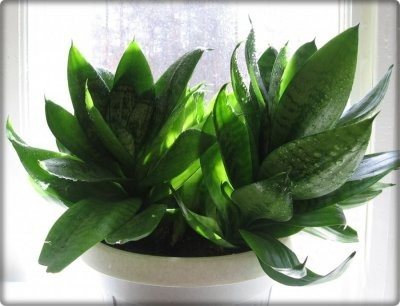

"Mother-in-law's Tongue", "Snake Skin", "Pike Tail" - as soon as they do not call this surprisingly unpretentious and very graceful plant. In the last century, it was in almost every home, but now it is gradually being replaced by exotic palms, orchids, even cacti.
Sansevieria - this is the name of this flower in scientific works. Yes, yes, scientists have seriously studied and continue to study the properties of this plant from the genus of asparagus, which feels great in a dry climate, can grow even on stony soil and at the same time has a lot of useful properties.
Florist reviews
The indoor plant Sansevieria (Pike tail) has been living in my house for about 9 years. I pinched off a small shoot from my mother-in-law, then we transplanted it into a jar, it gave a root and began to grow.Over time, the pike tail "demanded" a rather impressive pot, because it began to multiply by leaps and bounds. He was getting closer and closer ... My spouse cannot stand his flowering (he is allergic). It is interesting that such droplets appear on the flowers of this plant.
koala2014, Russia, Moscow
This is the most unpretentious plant of all that I have ever had. There was a time when I constantly lived in 2 houses and sometimes did not appear in the apartment where Sansevieria was faithfully waiting for me, for several months. All this time, no one watered the plant, and not only did it not bent, it also bloomed constantly.
ilek87, Russia, Moscow
I took this flower from a friend out of pity. He stood at her window for several years and slowly just wither away. Then it was flooded - stood in the water, then there was a drought in the ground. She was about to throw it away, and I picked it up. I changed the pot and the soil and planted three leaves without counting on anything. For several months the flower just sat in the ground, and after three or four months three leaves emerged from the ground - my joy knew no bounds. Now this flower is two years old. < …> This summer I suddenly saw some white dry leaves on the windowsill. It turns out that my pike tail is in full bloom. < …> The leaves of the pike's tail are very dense and therefore heavy. I cannot lift this flower pot. In addition to being beautiful, this flower is also useful. This flower is considered the best air purifier. The pike tail is directly necessary in a new apartment, in an apartment after renovation or after installing new furniture. The pike tail removes chemicals and paints from the air. And where there is clean air, there is higher immunity and less sickness.
gallin1234, Russia, Moscow
Structure


The well-known flower "Pike tail" (as it was named for the color and shape of the leaves, which really look like the tail of a pike) turns out to be a real treasure substances useful for humans.
It contains organic acids and active substances, in which saponins (sapo (lat.) - soap) are of great value: vegetable glycosides that dissolve well in water and alcohol. The solutions foam perfectly, for which the substance received such a name.
But saponins can be hazardous to health, under certain treatment, the extracted compounds can cause poisoning. Sansevieria also contains hemolytic sapogenin.
Useful properties of the plant
Despite all sorts of signs and superstitions, it has been proven that the pike tail has a beneficial effect on the microclimate and energy of the room, having a positive effect on the people in it. In offices, next to computers, you can often find this plant; it is believed that it takes away the negative effects of devices.
Positive impact:
- has medicinal properties;
- filters polluted air;
- saves indoor plants from pests;
- kills pathogenic viruses in the air;
- saturates the room with oxygen.
In addition, the plant has a beneficial effect on the energy of the room.
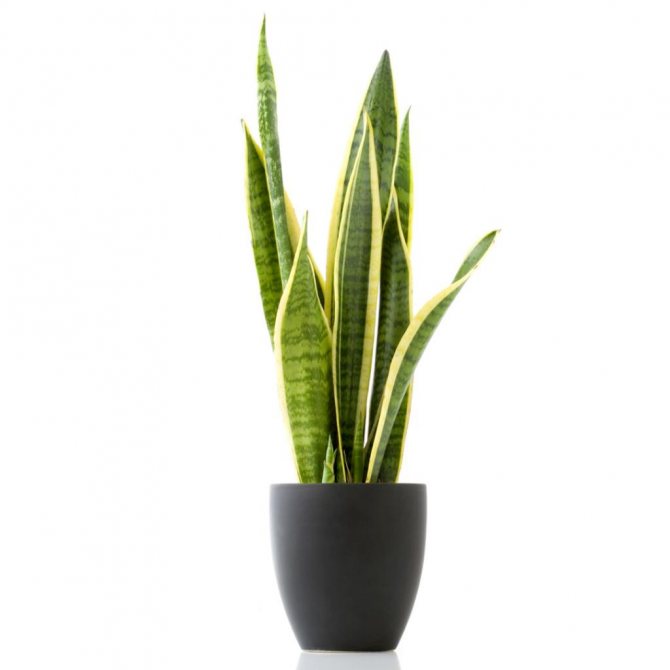

Benefit and harm
Beneficial features
Our grandmothers loved the "Pike Tail" not only for its unusual appearance and unpretentiousness.
True, they attributed to him and not too "good" qualities, for which they also called "Mother-in-law's language": in scandals, quarrels in the family, emotional tension. At the same time, it was noted quite rightly that sansevieria grows much better in an unfavorable emotional atmosphere than in houses where everything is fine. The answer to the question, where is the truth, and where is the myth, was given by scientists and Chinese experts in Feng Shui.
Feng Shui fans attribute this plant to simply magical healing properties: absorption of negative energy, anger, aggression, rudeness, as well as radiation from a computer, TV.


The plant is a warrior, surviving in the most difficult conditions, the leaves of which resemble a sword, helps to strengthen the spirit, learn new things, resist troubles,
gives efficiency and strength.
Sansevieria is used in cosmetology, it is part of detergents, preparations with substances obtained from this plant are used in traditional medicine to treat inflammation of the oral cavity, as an expectorant and laxative.
What is treated with sansevieria?
Indoors, this plant helps people with weather dependence, stabilizing pressure, boosts immunity, accelerates recovery with colds. The juice, like aloe juice, is tried and tested anti-inflammatory agent with otitis media, inflammation of the skin, accelerates wound healing, relieves itching, it also has a mild analgesic effect. Sansevieria will help with intestinal diseases, parasitosis, gynecological diseases.
Indications for use
If stress is a common occurrence in your life, get yourself this tireless assistant at home and at work. It will help you to normalize the situation without asking for anything in return.
- The skin of the leaves is used for burns and wounds.
- Decoctions from sansevieria are useful for infectious diseases of the genitourinary system, cystitis. They are also used to treat dermatitis, scabies and worm infections.
- A decoction of the root increases efficiency.
- The juice helps with ear pain, wounds and burns.
- Lotions from crushed leaves accelerate the healing of ulcers and inflammations.
- The smell of sansevieria helps with headaches. These properties of the "pike's tail" are preserved in the dry leaves of the plant, which are placed under a pillow or burned in a room where a sick person is.
- Sansevieria blooms are rare, but if you're lucky, a few sessions of aromatherapy will be a gift of a grateful flower that smells of vanilla and treats respiratory tract infections.
The origin and appearance of the plant
Sansevieria (Sansevieria) is a perennial evergreen plant of the asparagus family, a guest from hot and dry, rocky regions of the tropical and subtropical zones of our planet. The harsh conditions of arid places made it very hardy: it learned to do without moisture for a long time and survive, keeping it in the leaves.


The natural growing conditions of sansevieria made the plant hardy
Under natural conditions, sansevieria is common in India and the Indonesian islands of the Pacific Ocean, in Africa and on the island of Madagascar. It also grows in the western hemisphere - in southern Florida.
Leaves in various species can be erect or growing horizontally, green, yellowish or brown in color, with silvery, white or yellow dots, stripes, patterns, sometimes bordered by a strip along the edge of the leaf.
The plant does not have a separate trunk - the leaves grow from the rhizome. When blooming, sansevieria throws out an arrow with white sweet-smelling flowers. It mainly reproduces by basal processes.
In the old days, fibers were obtained from the leaves of this plant, which were used to make bowstrings. Since the beginning of the 20th century, the plant has become a popular home flower. There are more than 60 species and even more varieties derived from them.
The leaves of many indoor sansevieria can reach a height of more than 1 meter.
Ozonizer and air washer with prickly tips: the benefits and harms of sansevier
If you remember that sansevieria is inedible, pricks a little and does not experiment in this regard, the presence of a plant in the room will significantly affect the constant refreshing of the air due to the released oxygen. It is one of the most active room ozonizers, which also actively absorbs and neutralizes such hazardous substances as nitrogen oxide, benzene, formaldehyde and trichlorethylene.These substances are released into the air by various synthetic materials and means, which are sufficient in any apartment.
Sansevieria is used in African folk medicine. According to healers, the smoke from burning dry leaves relieves headaches. Broth - treats scabies and relieves itching. Pounded fresh leaves disinfect wounds and help with skin diseases.
Sansevieria leaves contain saponin. This substance is irritating to the mucous membranes of the nose, mouth and eyes if the plant sap gets on them. In contact with the skin, it does not cause irritation. But in both cases, it must be washed off with plenty of water. When the leaves are eaten (which just does not happen - children and pets are not careful), saponins cause nausea and vomiting. A certain danger is posed by the sharp and hard tips of the leaves, which can be pricked.
It is necessary to restrict access to the plant for children and pets.
Video: meet the flower "mother-in-law's language"
Plant harm
Is the pike tail poisonous?


Saponins for which sansevieria is valued, in large doses become poison... In medicine, they are used with caution, not recommended for pregnant women and children. There is no need to be afraid to breed this plant, it is dangerous only when consumed in its pure form inside.
If this wonderful flower has settled with you, do not forget about it. ability to harm.
- It is believed that too powerful energy of the "Pike Tail" can interfere with sleep, so you can not put it in children's rooms, bedrooms.
- Beneficial when applied to the skin, the juice becomes a potent poison.
- In cats that love to gnaw all the flowers in the house with avitominosis, sansevieria can cause dermatitis, intestinal upset, and vomiting.
- A dog that has eaten a cast of a flower will also vomit and vomit.
Signs of Pike Tail Poisoning
An adult sensible person is unlikely to decide to chew a striped green sansa leaf, but a child may well do it. The consequences of such an act are extremely painful and unpleasant, one burning sensation and salivation of what are worth!
Plant diseases
Overuse of watering is dangerous and leads to root rot. Yellowed leaf plates are a clear sign.
Helping the plant with the appearance of rot:
- Remove the pike tail from the pot.
- Remove the affected roots.
- Treat with antifungal agents.
- Dry for a week.
- Plant in new land.
Sometimes the pike tail suffers from large stature, high leaf plates fall and wither. Good support can save you from this problem.
Sansevieria is an unpretentious plant, if you create the necessary conditions for it, it will not suffer from diseases and pests.
Photo of sansevieria
Photos of "Pike Tail" are presented below:
The choice of container and soil for the plant
The pike tail has powerful roots, this must be taken into account when choosing a pot for it. Preference should be given to clay containers with thick walls, otherwise the growing roots can break them. It should be a small container, wide enough in diameter.
To create the right conditions, drainage is necessary. It is recommended to use expanded clay, broken brick, sand can be poured over them, which must first be sieved.
We make the soil from the following components: 2 parts of turf, 1 part of leafy earth, humus, peat, sand.
Mother-in-law's tongue
Many a well-known houseplant mother-in-law's tongue. Its official name is sansevier. In the common people, the flower has several original names: pike tail, cuckoo tail, the Americans call it snake skin, the British call it leopard lily and the devil's tongue. We have a more common name - mother-in-law's language. The people called it that for a reason, because the leaves of the flower really look like a long tongue.
Sansevier belongs to the Dracaena family. In India, Sri Lanka and tropical Africa, the plant can be found naturally.Mother-in-law's tongue has about 60 types.
In indoor floriculture, the most popular type is the cylindrical and three-lane sansevier. It is a herbaceous plant that has a creeping rhizome and long, upright, leathery leaves up to 1 m high and up to 5 cm wide.On both sides of the leaves are light and dark horizontal stripes.
It is believed that the plant blooms under unfavorable circumstances. The flowers are white with a characteristic pleasant smell, collected in racemose inflorescences.
Mother-in-law's tongue is the most unpretentious plant, grows well both in the sun and in the shade, is not afraid of drafts, tolerates the lack of watering and dry air well. The only thing is to be careful not to overflow the soil. The flower propagates most often by dividing the rhizomes. For planting, you need to use a wide and low pot. Few people know that in addition to its decorativeness and unpretentiousness, mother-in-law's tongue is also a medicinal plant.
Housewives
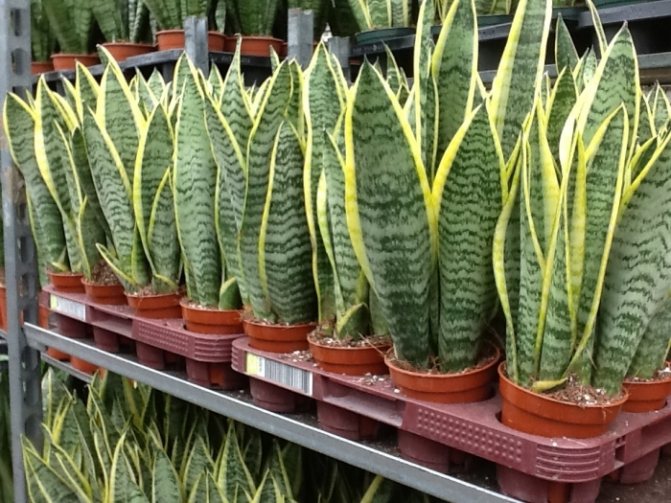

Sansevieria is a fairly well-known plant. Pike tail, mother-in-law's tongue, sansevier - all these are the names of one plant, very popular and beloved for its unpretentiousness and decorativeness. According to many gardeners, sansevier absorbs harmful radiation from a computer, TV, protects the owner from ailments and colds, helps to survive painlessly difficult life situations and changing weather conditions.
As you can see, caring for a sansevier at home is just happiness - there are few plants that can equal the amount of good they bring to the house. Caring for this representative of the flora is quite simple, the sansevier is unpretentious and not demanding. Despite the fact that the plant loves light, it also feels quite normal in the shade.
Of course, species with brighter coloration need more light than specimens with quieter foliage patterns.
Features of sansevier care
Temperature: mother-in-law's tongue (sansevieria) is a very unpretentious plant, but does not tolerate temperatures below 13 °, preferring an average annual 18 - 27 °.
Lighting: mother-in-law's tongue (sansevieria) is a light-loving plant, prefers bright diffused light, tolerates light partial shade, but does not like complete shading. Variegated varieties of mother-in-law (sansevieria) are more photophilous and respond well to direct sunlight. In winter, you need a bright room. A place on the east, west and south windows is well suited. The mother-in-law's tongue (sansevieria) will also grow on the northern window, but for the leaves to play with all the variegation and brightness of shades, the sun is needed.
Watering: the mother-in-law's tongue (sansevieria) is watered moderately from spring to autumn - the soil is allowed to dry out between waterings. In winter, mother-in-law's tongue (sansevieria) is watered limitedly about once every two to three weeks - depending on the temperature of the content so that the leaves do not dry out. When watering, especially in winter, do not allow water to enter the center of the mother-in-law's tongue outlet - this can cause decay.
Air humidity: for succulents like mother-in-law's tongue, air humidity is insignificant. But you need to wipe the dust off the leaves.
Fertilizer: in summer, mother-in-law's tongue (sansevieria) is fed monthly with liquid fertilizer for indoor plants. The newly transplanted mother-in-law begins to feed the tongue only after six months.
Transplant: the mother-in-law's tongue (sansevieria) is transplanted only when the pot becomes cramped - after about two years, young plants, after three years old plants. Since the roots of the mother-in-law's tongue (sansevieria) grow more in width, the pot for it should not be too deep, but wide.
Soil: the soil for the mother-in-law's tongue (sansevieria) should consist of - 2 parts of sod land, 1 part of leafy soil and 1 part of sand. Good drainage must be done.
Reproduction: mother-in-law's tongue (sansevieria) reproduces by parts of the rhizome. You can propagate the mother-in-law's tongue also with a sheet and part of a sheet. For propagation by a leaf, take an old leaf, which can be cut into pieces 4-5 cm long and dried a little in the air. Then a sheet of mother-in-law's tongue is planted with the lower end in the sand, and after rooting, it is transplanted into a pot with earth. But when the mother-in-law's tongue multiplies with leaves, they lose their characteristic pattern.
Pests: spider mites, thrips, mealybugs. Pests can be selected with your hands, wipe the leaves with a sponge, in case of severe damage, treatment with karbofos is used.
Sansevier transplant
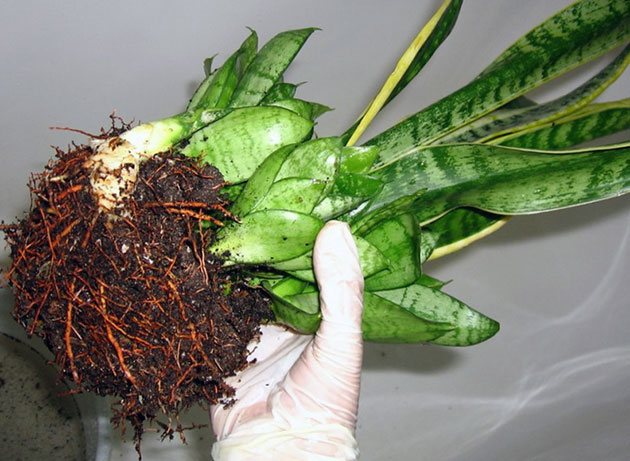

The transplant is carried out when the container for the sansveiere becomes too cramped, in young specimens this happens after two years, in older specimens - after three. The flower pot is selected wide, but not too deep. If you are wondering how a plant blooms, we do not recommend choosing a pot that is too large. flowering occurs quite rarely and only when the entire space of the vessel is occupied by roots. It is better to take special land, and put a drainage layer on the bottom of the vessel - broken shards, expanded clay, charcoal. 1. Repot the sansevieria in the spring every two years when strong root suckers have grown and the roots are visible through the bottom of the pot. Water the plant well.
2. Prepare a pot one size larger with a drainage layer and a layer of moist turf-based potting mix.
3. Maintain the old pot. The toes should be on both sides of the stems. 4. Carefully remove the old soil from the roots. Don't damage the roots. 5. Place the sansevieria in the center of the new pot with roots on the soil. 6. Add new potting soil to fill the pot. Make sure all roots are covered. Compact the soil. Leave it in the shade without water for two days to force the roots to grow into the soil.
Reproduction of sansevieria (mother-in-law's tongue)
Sansevier is propagated by lateral shoots, leaf and rhizome division. 1. Prepare a seedling tray or greenhouse with a drainage layer, a layer of soil and coarse sand (1cm). 3. Lay the sansevieria leaf on a hard surface and cut it into 1/2-inch cross-pieces. Make a small notch on the cut edge that is closer to the base of the sheet. 4. Insert each cut piece halfway into the sand with the notched side submerged in the sand. 5. Water well and cover. Remove the cover for 5 minutes a day to prevent rotting and to make sure the soil is not dry. Keep at a temperature of 21 °. New roots and leaves will sprout from the cut pieces. 6. When the new plants produce 2 or 3 new leaves, remove them from the soil and carefully separate them from the old leaf. Plant separately. Division of the roots of sansevieria When propagated by leaf cuttings, laurentii sansevieria lose their variegation. However, they produce root suckers that can be divided in the spring. 1. Prepare two pots with drainage layer and soil. 2. Remove the sansevieria from the pot and carefully remove the soil. 3. Carefully separate the roots and stems of the sansevieria with your hands. 4. Transplant both divisions in the usual way. Cleaning sansevieria Wipe the leaves of the sansevieria with a soft cloth or sponge dipped in lukewarm water. Support the sheet with your other hand. Do not use a cleaning agent.
Watering sansevieria Sansevieria cannot be waterlogged, otherwise they will rot at the base. Wait until the soil is dry to the touch. Drain off excess water after 15 minutes.
Diseases and pests of sansevieria.


1. Sansevieria leaves rot at the base. Too much water, especially in winter. Reduce watering and do not leave water in the plant outlet.
2. The edges of the leaves of the sansevieria are damaged. The plant is not pot-stable. Make the pot more stable by placing it in an outer container.Perhaps the sansevieria was left by the window and was affected by the cold. Move away from the window.
3. Brown spots on the leaves of sansevieria. Waterlogging. Do not let the plant dry out completely, but water less often.
4. Sansevieria leaves are pale. There is not enough light. Move to direct light.
5. White woolly spots on the underside of sansevieria leaves. Mealybug. Remove pests with a sponge dipped in methyl alcohol, or spray with malathion or a systemic insecticide.
The most common problem in growing sansevieria is partial or complete loss of the characteristic pattern on the leaves.
Even seemingly perfectly healthy sansevierias can suddenly release "blank leaves" or change the characteristic pattern that can be admired on other leaves. But if you really want them to become the main decoration of the interior, you will have to pay a lot of attention to this culture. In order to admire the variegated patterns and lines on the leaves of sansevieria, it is necessary to provide the plant with a much stricter selection of growing conditions than for those plants whose leaf color does not matter. And first of all, this applies to the amount of light: variegated sansevieria are much more light-dependent than green-leaved ones. They should be in conditions not darker than the diffuse average penumbra. Pay attention to other parameters as well. For variegated plants, it is imperative to strictly select containers, giving preference to low but wide pots that optimally correspond to the growth characteristics of the rhizome. The substrate that you use for planting sansevieria must also be carefully selected: light, loose earth mixtures with sand, for example, special mixtures for cacti that provide an optimal moisture regime and the health of the root system is the main guarantee that the leaves that will be active grow, will retain their beauty and decorative features. Variegated leaves on sansevieria are formed only if there is a sufficient supply of not only basic elements in the soil, but also micronutrients. Fertilizers for the plant are applied almost all year round, with the exception of the winter months, once a month using a standard dose of fertilizers for succulents and cacti during watering. It is in such fertilizers that the ratio of microelements that is optimal for variegated sanseviers is contained.
A SOURCE
Pharmacological composition
The composition of the leaves of the flower includes such substances: hemolytic sapogenin, abamagenin, several organic acids. And the main active ingredient is saponins. They are found in many medicinal plants.
This substance is considered poisonous. In pharmacology, laxatives, choleretic and diuretic drugs are produced from it.
When administered intravenously, they in small concentrations contribute to the destruction of red blood cells. And when taken orally, they are not at all toxic, because they are destroyed in the intestines.
Landing rules
Planting with seeds is practically not used, but if they are, you can sow, cover with foil, put in a warm place. Seedlings will appear in 2-4 weeks. After germination, the seedlings dive, when they get stronger, they are seated in separate pots.
Planting a purchased or perennial plant is carried out by the transplant method.
- The size of the pot is selected.
- They buy or prepare the soil on their own.
- Drainage is poured onto the bottom of the container and a layer of soil.
- Set the plant, sprinkle it with earth on the sides, tamp it lightly with your fingers.
- Water, put the pot in a permanent place.
Healing properties and use of mother-in-law's tongue
The medicinal properties of the plant have been known for a long time. First of all, sansevier is valued for its anti-inflammatory and analgesic effect, the ability to heal wounds, cuts, and stop bleeding.It is used in the treatment of otitis media, tonsillitis, inflammation of the appendages, cystitis, gastrointestinal diseases and other ailments. The smoke from this burning plant is believed to help relieve headaches.
- With periodontal disease, juice from the leaves of the mother-in-law's tongue will help, which must be rubbed into the gums, and you can also simply chew the leaves.
- In case of inflammation of the appendages, cystitis, use the following tincture: fill 1/3 of the glass with crushed plant leaves, pour vodka. Infuse in a dark glass bottle in the refrigerator for three weeks. Then the tincture should be filtered and stored in the same bottle. Take two weeks, twice a day for 1 tbsp. spoon after eating.
- For infectious diseases of the gastrointestinal tract (gastroenteritis, enteritis, colitis, gastritis and others), the tincture is used as follows: 50 ml. tincture (according to the recipe set out above), dilute with 50 ml. boiled water. Consume in two hours, approximately 7-8 times a day. To achieve the best effect of treatment, it is advisable to also do enemas using a decoction of sansevier: pour 50 g of leaves with one and a half liters of boiling water and boil for two minutes over low heat, let it brew for 2 hours.
- For otitis media, fresh juice should be instilled into the ears, which will help relieve inflammation and reduce pain. The course of treatment is 7 days, you need to bury the ear canal three times a day, 1-2 drops.
- For cuts, scrapes, bruises and bruises, the mother-in-law's tongue will help. It is necessary to fix the fresh leaf with a bandage on the damaged area. Thanks to the healing properties of the flower, the wound is disinfected, bleeding will stop, the bruised tumor will disappear, and the size of the hematoma will also decrease.
- A decoction will help get rid of scabies and itching: pour a fresh chopped leaf with 1 glass of hot water and boil over low heat for about 10 minutes, strain. Drink in small sips throughout the day. You can make lotions from the decoction for external use.
Sansevieria transplant
For normal growth and flowering of the plant, a fairly tight pot is needed. Therefore, the transplant is carried out only as needed, approximately once every 2-3 years.
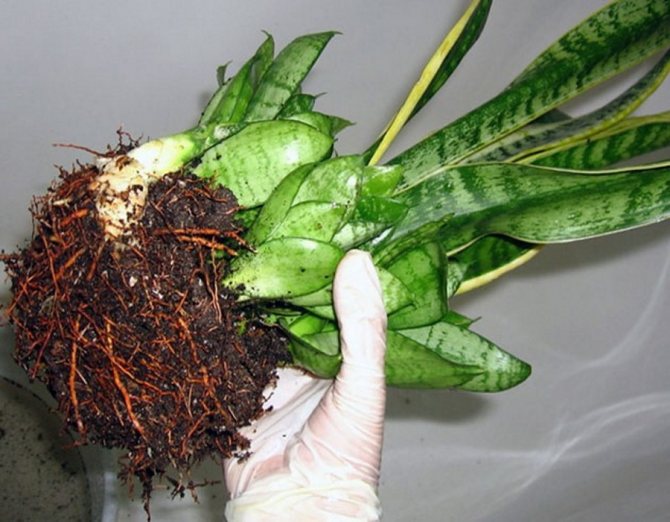

The transplant is rarely carried out, only when the roots become cramped in the pot.
It should be remembered: the root system of sansevieria is so powerful that when the entire volume of soil in the pot is occupied by the roots, they either break the pot or begin to protrude upward. This will be a signal that it is time to transplant sansevieria.
What soil and pot are needed
The soil for sansevieria should be moderately sandy, well permeable to water and air. The classic formula is “leaf land: turf land: sand = 1: 1: 2”. Purchased land is quite suitable for cacti and succulents.... It is advisable to add sand, pebbles and a little clay to it. A prerequisite is the presence of a powerful drainage layer at the bottom of the pot (for example, pebbles or expanded clay balls). It should occupy at least 1/4 of the pot's volume.
The pot is needed deep, 2-3 cm wider than before. For vertically growing varieties, it is best to use massive clay pots that provide resistance to long, heavy leaves.
Important! When transplanting a plant into a new pot, it should be tied to a support for the time of rooting and compaction of the soil, since the leaves can outweigh and pull the plant out of the ground.
Transshipment with replacement of land
Step by step description:
- Take a pot slightly wider than before, add layers of drainage and then wet soil.
- Water the plant well. After a while, remove it from the old pot, holding the leaves at the base.
- Remove old soil from the roots, being careful not to damage them.
- Place the plant in the center of a new container, add soil mixture until the roots are completely covered. Tamp down.
- For the next 2 days, keep the plant in the shade and do not water it: this will cause the roots to grow into the soil.
Important! When transplanting a plant into a new pot, it should be tied to a support during rooting and compaction of the soil, since long and heavy leaves can outweigh and pull the plant out of the ground.
Mother-in-law's tongue is a wonderful air purifier
Even if we do not use infusions and decoctions from this plant and it is simply present in our room, then in this way it also improves the conditions of our life. The thing is that mother-in-law's tongue is recognized as a very effective natural filter for cleaning indoor air, it is simply a champion in the production of oxygen.
The plant is capable of absorbing harmful radiation from TV and computer. Sansevier has a positive effect on office workers who work at computers, improves their well-being and ability to work. The leaves of the "dust collector" should be cleaned of dust at least occasionally so that this ideal filter does not stop working.
To care properly - to water less?
If you recall the harsh conditions of natural growth of sansevieria, it becomes clear that this is one of the most unpretentious plants that can withstand significant temperature changes, various illumination and drought.
Important! The only trouble for the plant during care can be excessive watering and the ingress of water into the center of the leaf outlets (especially in winter).
Nevertheless, there are comfortable, acceptable and unacceptable modes for keeping sansevieria. In particular:
Table: plant requirements for temperature and other conditions of detention
| Conditions | Temperature | Illumination | Watering | Top dressing |
| Comfortable | Room temperature (+ 22 ° С) | Bright sunlight - can be placed on the south window |
| From time to time during the growing season |
| Acceptable | Wide range: from + 12 ° С to + 30 ° С throughout the year | Can be placed at the back of the room | Without watering 2-3 months or more | Without feeding |
| Unacceptable | Long-term maintenance in the range of + 5 ° С ... + 12 ° С | Very dark room (leaves become small and just green, no patterns) | Abundant frequent watering | Frequent feeding |
Watering and feeding
The only mistake that creates serious maintenance problems is over-watering the plant and water getting into the leaf rosettes during watering, especially in winter, when moisture evaporation is slow (the rosettes dry out too slowly). The first signs of waterlogging are:
- loss of leaf elasticity, their yellowness, lethargy;
- yellowing and drying of the tips of the leaves.
If watering is not limited in time, the root system will begin to rot. In this case, it is necessary to transplant the plant, after carefully examining the roots and removing all those damaged by rot.
Benefits in the house from mother-in-law language
In addition to the fact that the plant itself filters the air, it helps to cleanse the space of bad energy, is able to absorb the energy of negative evil thoughts and create a cozy atmosphere. Another mother-in-law's tongue helps a person achieve his goals, inspires him to move forward. Promotes rapid assimilation of knowledge, especially useful for those who complain of frequent forgetfulness.
The plant is a real talisman for students and teachers. Mother-in-law's tongue, possessing the ability to survive in poor conditions and having an unassuming character, transfers these properties to its owners, increasing our adaptive abilities and resistance to viral, colds and other diseases.
Reproduction methods
There are several ways to reproduce mother-in-law's tongue. Moreover, monochromatic varieties are propagated by cuttings, shoots or division of the rhizome, and variegated ones - only by dividing the root into parts.
- Leaf cuttings. The leaf is cut into pieces, the pieces are inserted into moistened soil, and rooted. The procedure is carried out in the spring.
- Division of the rhizome. The plant is removed, the root system is cleaned from the ground, the root is divided into 2-3 parts.They make sure that there is a growth point at each. The slices are sprinkled with crushed coal. Delenki are planted in the soil, moistened.
- Reproduction by shoots (shoots). Children are separated from the mother plant with a sharp knife, making sure that part of the root remains, and planted in pots.
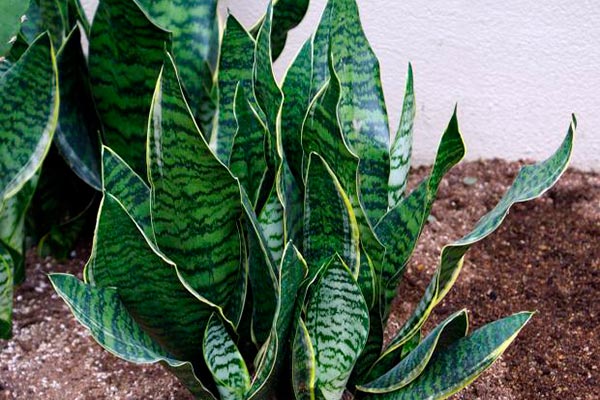

What soil is needed for sansevieria
The plant does not like acidic soils - the peel on the flower cracks from the high nitrogen content. The best option is a soil with a neutral ph (6-7). The loose, lightweight structure provides good aeration to the roots.
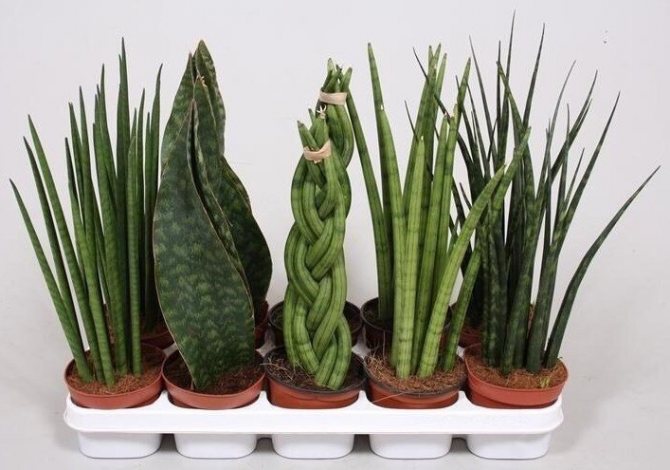

Sansevieria
Substrate for transplanting sansevieria is prepared according to the recipe:
- the same amount of sand is added to the 1st part of the peat;
- make 3 parts of sod or leafy land, as well as ½ part of humus;
- a little vermiculite or perlite is added to the mixture (to absorb excess moisture);
- the substrate is poured into a pot and used for transplanting a flower.
You can take a different composition of the soil: from sand, deciduous and sod land in a ratio of 2: 2: 6, respectively.
Landing capacity
The root system of the “mother-in-law's tongue” develops slowly and is located shallowly.


Therefore, the container for planting must be chosen so that it is wide but not deep and the size corresponded to the size of the plant.
Too large planting capacity of sansevieria is difficult to master. Pots for mother-in-law's tongue are chosen from the calculation: the height is half the diameter - for low varieties. For medium-sized and tall specimens, the height of the container may be equal to its diameter.
In addition, the bottom of the container must have drainage holes of sufficient size to ensure efficient drainage of excess moisture.
The material of the optimal planting capacity is porous, which ensures the evaporation of excess moisture and respiration of the roots. Best to choose ceramics without continuous glaze.
Planting and replanting a pike tail: optimal soil, suitable pot and other nuances
Soil for sansevier needs lightweight, capable of drying quickly and not accumulating moisture. It is better to choose a soil that is poorly nutritious, for example, for cacti or succulent crops. It is necessary to independently prepare the land for planting sansevieria from leafy soil and sand, taking them in equal parts. It is advisable to sterilize the mixture before use. It can be ignited in the oven, steamed in a water bath, or spilled with a weak (1 liter 0.5 gram of powder) solution of manganese, and then dried.
The root system of sansevieria is superficial
Transplant this plant as the pot is filled with roots. Young sansevierias usually change the pot every 10 months, and for older ones, at five years old, when the flower becomes cramped.
The new container for the plant should be shallow, but in diameter it should exceed the previous one by one and a half to two centimeters. The root system of sansevieria is shallow, so it makes no sense to use deep pots for it.
The transplanted flower should be fed only after 5–6 months.
Video: how to transplant sansevieria at home
The benefits of the plant
In addition to the unpretentiousness and attractive decorativeness of sansevieria emit a large volume of oxygen into the room
, destroy bacteria, purify the air in the room, and absorb chemical vapors.
In the Feng Shui tradition, it is believed that a plant absorbs negative energy, as well as absorbs radiation from a computer and TV.
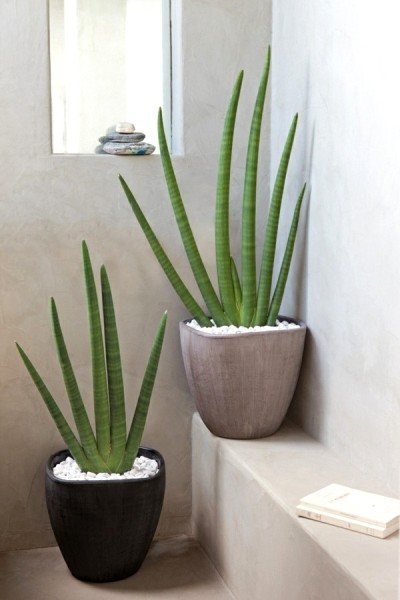

In the classroom or in the room where they are studying, sansevieria will help to assimilate new knowledge, fill the room with an atmosphere of learning new material.
Sansevier is a warrior plant, with leaves as swords, it helps to resist failures, strengthens fighting spirit and mood.
Sanseviera improves metabolism
in people who are constantly in the same room with the plant. It is believed that sansevieria is similar in properties to aloe. In case of abscesses on the skin, the sansevieria leaf is allowed, washed and firmly applied to the site of injury.Sansevieria heals and disinfects wounds on the human body.
Sansevieria is one of the favorite colors of designers and decorators. Greens organically fit into a modern interior, and given that it steadfastly retains an attractive appearance, it can multiply quickly if planted in time.
Strong ropes are made from the leaves of sansevieria, which are not damaged by the sea water. In some eastern countries, the "pike tail" is used in folk medicine.
Can sansevieria be kept at home?
In Russia, this plant is most often called the mother-in-law's tongue, since its leaves have a sharp tip, and, according to popular belief, like the mother-in-law's tongue, can bring major quarrels and problems into the life of a young family.
There is a widespread belief that keeping the mother-in-law's tongue in the house is not worth it at all - it causes problems and scandals. However, this opinion is far from the only one. According to other beliefs, mother-in-law's tongue, on the contrary, absorbs negative energy and serves as a kind of "lightning rod" for problems.
Description of the flower
Sansevieria belongs to the decorative leafy species of the asparagus family. In its natural habitat, it is found in the tropics of Africa, India, in the humid forests of the North American continent. The pike tail grows up to 120 cm in length. From the rhizome, green, powerful, fleshy leaves stretch vertically upward, with a spectacular ornament of a yellow or light green hue. There are 2 types of sheet plates:
- long vertical;
- short wide.
The edges of the foliage in both variants are solid, and the tips of the leaves are pointed. The plate is completely covered with skin. This film protects the plant from excess moisture evaporation. Mother-in-law's tongue grows rather slowly, on average throwing out 2-3 new leaves per year. If you follow the recommendations for care in the spring, sansevieria blooms. From the rosette of leaves, a long peduncle grows, strewn with fragrant, usually racemose inflorescences. In an apartment, the plant blooms for 2 weeks, in its natural habitat - all year round. At night, the buds "fall asleep", closing, after dinner they bloom again.
Sansevieria: flowering (video)
The plant sap extracted from the foliage of an ornamental culture is used in the treatment of otitis media and inflammatory processes of the skin. The smoke from burning foliage has long been used as a very effective remedy for headaches. A flowerpot with "mother-in-law's tongue" located near a computer or TV is able to absorb a significant part of radiation harmful to the human body.
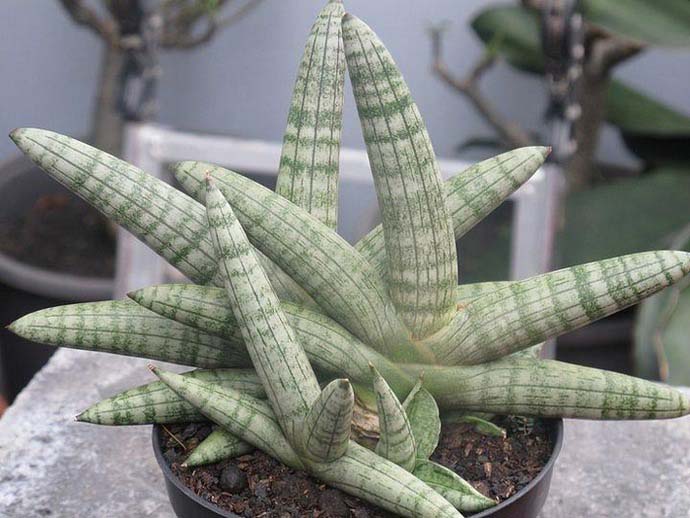

Care problems
No matter how strong the wolf's tail is, sometimes unpleasant problems arise: the leafy part softens, turns yellow, dark brown spots appear, and the perennial dies off.
This happens for two reasons:
- Due to waterlogging of the soil... You can save it by transplanting, while removing the affected leaves. If the root itself is damaged, the intact parts should be rooted - the top of the rosette, part of the leaf.
- At a very low temperature... In this case, the "tail" must be rearranged into a warm room, removing diseased leaves.
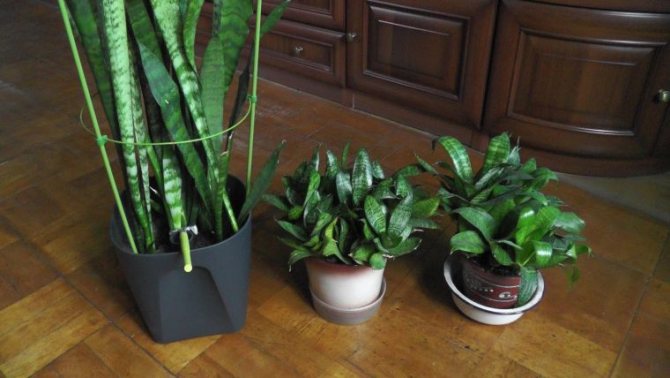

Conditions for a flower
Sansevier calmly tolerates low light, but it is not recommended to keep it all the time in the far corner of the room. In order for a flower to look beautiful, it needs light. For moderate sunbathing, he will answer with gratitude in the form of juicy leaves of bright colors. But sansevieria does not like direct rays or long daylight hours.
As for the air temperature, then the pike tail is even more unpretentious than with lighting. The flower calmly tolerates daily changes, sharp temperature jumps.
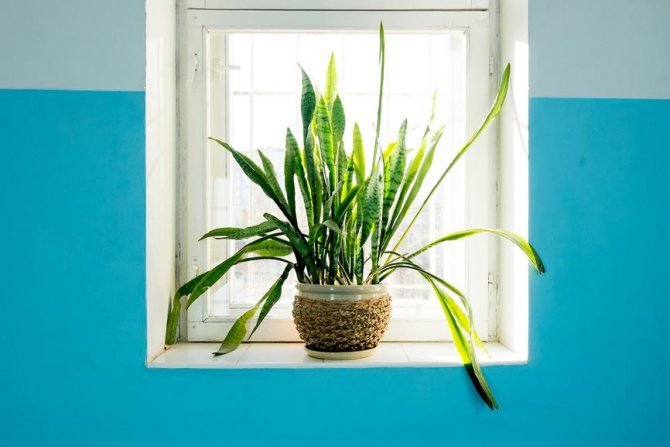

Lighting for a sansevier should be moderate
Seasonal conditions of detention: air temperature, humidity, lighting - table
| Condition | Autumn and winter | Spring and summer |
| Air temperature | It is necessary to adhere to + 14–16 ° С, a higher temperature is permissible. But it should not fall below + 10 ° С. | It is recommended to monitor the temperature rise, optimally not higher than + 26 ° C. |
| Air humidity level | Moderate. Sansevieria does not require spraying. | |
| Lighting | Bright and diffused light, partial shade is also suitable. Sansevieria can even grow in the shade. The best location is an east or west window. | Shade the plant in the middle of the day. |
Harm to humans
Sansevier safe for humans
and is not harmful, however, the plant should not be placed in the nursery.
Saponins, substances found in the leaves of sansevier, are not recommended for pregnant women and children. The best place for a flower is a living room, a loggia.
The plant is dangerous only when ingested, therefore, various tinctures that traditional medicine suggests drinking should be used with caution.
It is also believed that the powerful energy of the plant may interfere with sleep in adults and children
... In pets, when consumed, it causes indigestion, nausea, vomiting. In case of poisoning of children, you need to induce vomiting, give activated charcoal and call a specialist.
When transplanting a plant, be sure to use gloves, you can use glasses to protect the eyes from the juice. The trimmed parts of the sansevieria are disposed of in a package or destroyed.
Plant transplant is the most important moment
The main item providing good care is the transplant of the sansevieria.
If you purchase a pet in a store, the land must be changed. A lot of peat is usually superimposed in store pots, which absorbs moisture well and gives it away poorly. This can lead to decay.
Change a small shop pot with larger dishes - there are not enough minerals in a small flower. Check for root damage.
A transplant is needed if the roots grow outward, on top of the pot. Rotten leaves, roots must be removed.
Before picking, the flower is not watered - it is enough to knock on the "nest", pull out the root, and plant it in slightly moistened ground. It is not recommended to water immediately after transplanting.
Reviews and advice to flower growers
The mother-in-law's house flower tongue, due to its properties, makes home living conditions more comfortable. Reviews indicate that the plant really helps to cope with fatigue, produces oxygen, accumulates negative energy.
In order for a decorative or monochromatic "green friend" to delight longer with its healthy appearance, it is necessary to follow several rules of care, cultivation and maintenance at home.
- Watering the mother-in-law's tongue is only necessary with settled water at room temperature, pouring it not into a pot, but into a pan.
- It is better if the water for irrigation is rain or distilled.
- The plant will begin to bloom only in a wide but cramped vessel, when the roots completely fill the entire volume of the pot.
- If self-prepared soil is used during planting, it must be calcined or spilled with a solution of potassium permanganate.
- For better rooting of parts of the leaf, you need to moisten the soil, cover each piece with a glass jar or a cut plastic bottle.
Observing the simple rules of care, you can grow beautiful ornamental plants of any kind, decorating an apartment, office, hospital corridor or school classroom with them.
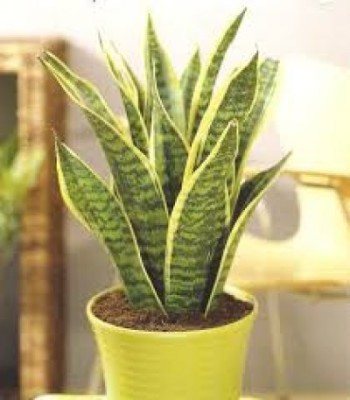

Sansevieria is a plant with succulent leaves. The plant got its name in honor of the name of the prince of Italy San Severo Raimondo de Sangro, who contributed to the development of botany.
It comes from the tropical latitudes of Africa. In the homes of Russian amateur gardeners, three-lane sansevieria is most often found. The plant is also called mother-in-law's tongue or pike tail due to its external features.
In Europe, they began to grow about two hundred years ago as an ornamental indoor plant.Sansevieria is interesting for its unusual flowering nature and the ability to give a rare and fleeting beauty of its culminating period of development.
The scientific name of the mother-in-law flower language and its external characteristics
The scientific name of the plant in Latin is Sansevieria
(sansevieria / sansevieria). It is also popularly called pike tail, snake skin or leopard lily. Some growers call it the language of the devil.
Mother-in-law's tongue has a well-developed root system, turning into tough, durable leaves. The green crown is able to achieve 1 m high
... In addition to being quite long, the leaves are pointed at the top. Sometimes a crown can be found that has a direction horizontally to the soil, or spread out to the sides. The color of the leaves can take on different shades and have different intensities from bright green to green-brown. The pattern on the leaves can be either stripes or irregular spots.
During flowering, whitish-green stamens appear, surrounded by thin petals. They form a dense inflorescence located on a rather elongated peduncle, which has a straight shape. The flowering period lasts at least a week, this time is enough to enjoy the delicate aroma emanating from the flower vaguely resembling vanilla. At the same time, the flower itself is able to release a small amount of nectar, which in natural conditions strongly attracts insects that contribute to its pollination. A photo of the flowering mother-in-law tongue can be seen below.
Not all types of pike tail bloom the same way, so during the period of its flowering, the "Kirka" has small berries that contain seeds. The domesticated plant rarely bears fruit.
The ideal climatic conditions for the devil's tongue are tropical and subtropical, as it grows naturally in Asia, India and Africa.
Due to the intense heat, sultry air and drought of mother-in-law, the tongue is distinguished by high vitality and unpretentiousness. Thanks to this, it is able to grow both on flat terrain and on rocky surfaces.
In the wild, the plant is used:
like a hedge;
- a popular medicine in folk medicine;
- material for making ropes and even fabrics.
This houseplant is surrounded by a huge number of superstitions and folk signs.
There are a number of scientifically proven aspects that indicate useful properties
germination of this indoor plant in the house:
- Sansevieria holds the record for oxygen production. Thanks to its presence in the house, conditions for a comfortable living of a person are improved.
- It is known that the tongue of the devil is a powerful natural filter that removes human fatigue.
- Absorption of negative energy gives the mother-in-law's tongue a huge advantage compared to other houseplants.
Mother-in-law's tongue has a number of useful properties:
In folk medicine, various infusions and freshly squeezed juice of this indoor plant are actively used for the treatment of:
- scabies;
- sore throats;
- periodontal disease;
- inflammation of the female reproductive organs;
- otitis media;
- inflammation of the genitourinary system;
- diseases of the gastrointestinal tract.
Flower diseases
"Mother-in-law's tongue" is unpretentious, so his diseases are more often associated with pests than with poor care. But still, sometimes florists' mistakes become the cause.
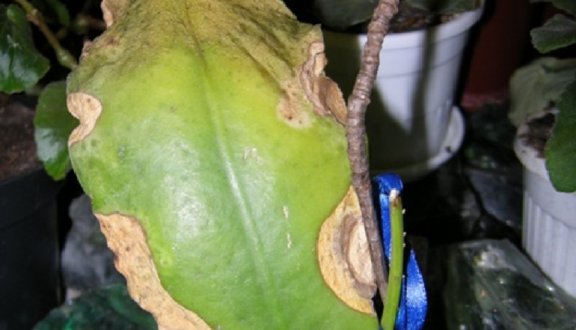

Dark spots on the leaves
Rusty blotches are a sign of abundant watering in cold weather or during periods of solar activity. For treatment, use the means "Topaz". Dark spots are black rot that is removed by foundation. Light brown areas are a sign of fungal infection. In this case, use the same drug.
Yellow leaves
Violation of leaf pigmentation indicates inaccurate watering when water gets on the flower during a period of high sun activity. The plant is harvested for several days in partial shade and monitored.
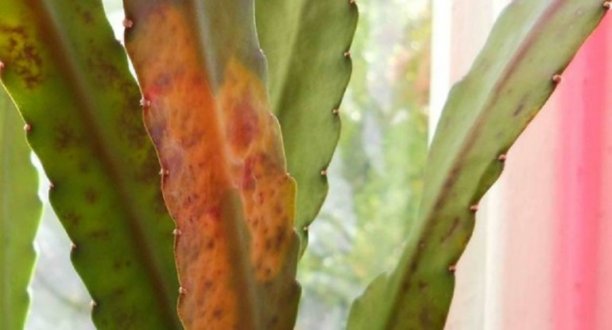

Flabby leaf tips
Loose leaves are a sign of systematic over-watering or hypothermia. In this case, it is difficult to rehabilitate the plant, since the roots are probably damaged. The easiest way is to cut off the remaining parts of the shoots and propagate the cactus by cuttings.
Rolling the leaves
Folding of leaves and shoots occurs when there is a lack of moisture or prolonged exposure to bright light. Treatment involves the normalization of the irrigation regime, the shading of the windows at a time when the sun is especially bright.
Yellowing of peduncles
A violation of the pigmentation of a part of the shoot indicates improper moisture, chemical or sunburn. It is necessary to rearrange the plant in a place inaccessible to direct rays, apply fertilizers with caution (they should not fall on the stems), reduce or increase watering.
Flower "Mother-in-law's tongue" is unpretentious in care, and at the same time is aesthetic. It will decorate any room, and in the summer - a balcony or loggia. Following simple tips, instructions with photos and videos will help ensure the plant has the right living conditions and a healthy appearance.
Reproduction of sansevieria
If the time to plant the mother-in-law's tongue fell on the spring, you can combine this procedure with reproduction. During this period, all biological processes proceed at an accelerated pace, the active movement of juices will help the plant to take root faster.
Novice florists are interested in the question of how sansevieria reproduces. This event is carried out in several ways:
- division of rhizomes;
- cutting off side shoots;
- fragments of a leaf plate.
The latter option does not allow you to preserve the color of some species of pike tail, but the method still remains popular. This method is especially good if the root system is sick and becomes unusable.
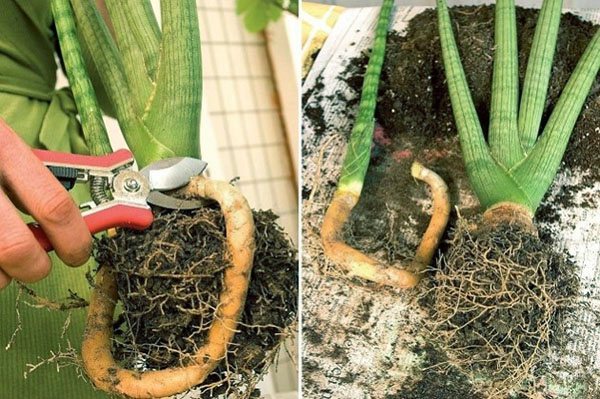

Preparing for transplant
Sheet
You can also take advantage of the propagation of sansevieria by a leaf in the case when an already formed plate breaks off. At the same time, the mother-in-law's tongue can be rooted both in the ground and in a cylindrical container with water.
The soil
In order for sansevieria to take root, leaf propagation is carried out in the wrong soil, which is intended for transplanting a flower. In this case, the loose substrate should contain components in the following proportion:
- 1 part of sand and humus;
- 2 parts of sod and leaf land;
- the presence of charcoal is mandatory.
Another composition is suitable for reproduction: from leaf and sod land with the addition of perlite (all ingredients are taken in equal parts). The soil before planting must be sterile (calcined) and moist.
What kind of pot is needed
The rules for choosing a container for a pike tail were mentioned above. The stalk with which the plant will propagate is small. Therefore, you should not take a spacious pot. For a start, a container no more than 8 cm in diameter and about 5-6 cm deep is quite suitable.
As for the material of the pot, it must be breathable so that the future roots can breathe. Ceramics (clay) are best suited for this. In addition, it perfectly absorbs water, playing the role of additional drainage.
Agrotechnics
To know how to properly propagate sansevieria with a leaf, follow the step-by-step instructions. At the same time, despite the common points, there are differences in earthen and water rooting.


Leaf propagation
First, perform the following actions:
- a healthy, undamaged leaf is cut from the uterine bush;
- the plate is cut into strips of 10-15 cm, moving with a sharp knife perpendicular to the veins;
- on each fragment, the bottom and top are marked with a marker (this is important when planting).
Important! If part of the plate is buried in the ground or lowered into the water with the wrong cut (against the movement of the juices), you can not wait for the roots.
Features of reproduction of sansevieria leaf
| In the ground | In water |
|
|
Planting leafy parts directly into the substrate is preferable - rooting will occur faster (after 1.5-2 months). New shoots from the leaf can be expected in 7-8 months. For this to happen, the following optimal conditions are maintained:
- air temperature - within 21-25 °;
- luminous flux - only diffused;
- the substrate is moderately moist (watering through the pan).
Note! When propagated by a sheet of mother-in-law's tongue, some growers practice the greenhouse effect. It is undesirable to do this - due to high humidity, the cuttings can rot.
Why remove the growth point from sansevieria
The purpose of reproduction is not just to get a new plant, but also to preserve all its characteristics. Not every method satisfies this desire. In varieties with variegated leaves, color can only be preserved by propagation by layering.
The older the plant, the less likely it is to get planting material from it. After 5 years, the flower practically does not form root layers. To stimulate the mother plant for development, you need to carefully cut (and not twist) the growth point and remove 2-3 top sheets.
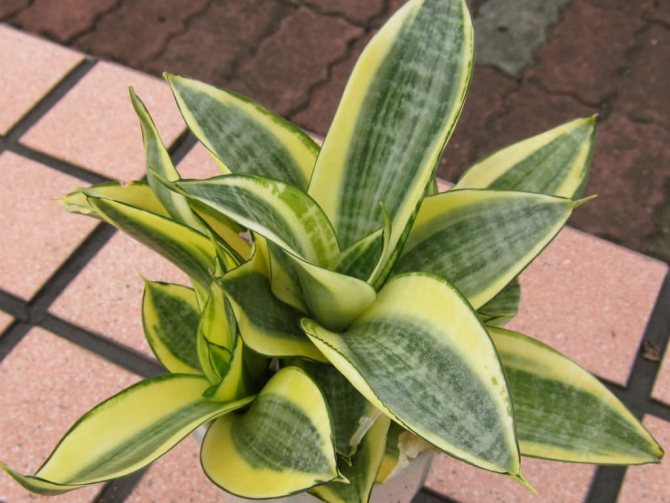

Sansevieria with layering
The plant will immediately redirect forces to the development of the rhizome, after 1.5 months several good layers will develop on the bush. They are cut off and placed in pots. After that, adult sansevieria can grow for several more years (until the foliage dies off).
Reproduction of "mother-in-law"
It is recommended to transplant sansevieria when the pot becomes cramped for it - after 2-3 years.
- reproduction by dividing rhizomes - with a sharp clean knife, the rhizome is cut into pieces about 10 cm, while for each piece of rhizome there should be several rosettes of leaves. Sections must be dried and planted in the substrate.
- propagation by leaf cuttings - the most common types of sansevieria can be propagated by leaf cuttings. In this case, an adult plant will grow from a cuttings in two years. This propagation method is not used for variegated varieties with yellow stripes, since the young plant in this case will not have stripes. The exception is three-lane sansevieria with a yellow stripe along the edge of the leaf. It is necessary to cut off the leaf at the base of the outlet at an acute angle near the yellow stripe and place it in a pale solution of potassium permanganate so that only the yellow corner of the leaf is in the solution. It is characteristic that the spine appears precisely in this part of the sheet. Exactly at the same slope as in the solution, it is necessary to plant the cutting in the soil. After a few months, a rosette similar to the mother plant should appear. And the sheet from which the rosette appeared must be removed with a sharp knife.
- reproduction by children from air rhizomes - some varieties of "mother-in-law" give children on air rhizomes. They need to be carefully cut with a sharp knife, dried and planted. In this case, roots should form within a couple of months.
- propagation by seeds - seeds are sown in a greenhouse in the soil from a mixture of turf, leafy earth and sand in a ratio of 1: 2: 1, respectively, and placed in a warm and bright place. The seeds sprout in a couple of weeks, and after a month, the plants must be planted in separate pots.
Potential harm
The foliage of any kind of sansevier contains a significant amount of saponins. These components belong to the category of fairly toxic substances that make up some diuretics, choleretic and laxatives. The ornamental plant should not be placed in areas accessible to pets and children.
Nevertheless, sanseviera are among the very unpretentious and hardy indoor plants, which are welcomed by beginners or insufficiently experienced flower growers.And if the cultivation technology is observed, problems with this indoor decorative culture do not arise.
Pests and the fight against them
The flower is affected by spider mites, thrips, mealy worms:
- Tick infestation can be seen by the color of the leaves - they become pale yellow, with whitish spots. This is facilitated by too dry air in the room, or an infected plant brought home.
- Thrips are deposited in numerous colonies on the underside of the leaves, while the upper part of the leaf, gray-brown with a silvery sheen, can be observed.
- Mealybug finds a place of residence at the base of the outlet, begins to suck the juice from the peduncles and leaves. They can be identified by the characteristic curvature of the sheets.
Flower pest control measures are simple: regular wiping with a cloth dipped in an infusion of citrus peels, spraying with phytoverm, actellik, decis.
If a mealy worm is detected, remove them with your hands, process the flower with karbofos.
A perennial can get sick with excessive watering - this is the main reason because of which it withers, the leaves wither, brownish spots appear on them, the roots rot.
Changes in "behavior" can also be observed with a lack of light, high humidity, and a sharp change in illumination.
Popular types
Plants belong to the genus of stemless and evergreen perennials. Sansevier is a popular herb from the Asparagus family and is often found naturally in regions characterized by dry and stony soils.
| Species name | Description of the plant | Species features |
| Sanseviera large (S.grandis) | The leaf rosette consists of two to four juicy and fleshy leaves of a light green color | Leaves with attractive dark transverse stripes and pronounced reddish edging |
| Sansevier hyacinth (S. hyacinthoides) | A half-meter plant with a bunchy leaf rosette, including two to four leaves of dark green coloration | The presence on the leaves of a light green W-shaped shading and a reddish or whitish marginal border |
| Sansevier Duneri (S.dooneri) | A mild leafy succulent plant, forming a leaf rosette of two dozen flat and erect leaves | The foliage has a characteristic dark green patterned pattern. |
| Sanseviera graceful (S.gracilis) | Perennial succulent plant with leathery, oval, long, pointed leaves of grayish-green coloration, covering the stem base | On the foliage there is a gray-beige pattern in the form of transverse stains |
| Sansevier Kirk (S. kirkii) | The plant is characterized by a relatively shortened rhizome and short leaf rosettes, represented by spotted leaves | Varieties with brownish or reddish-brown foliage are known in floriculture. |
| Sansevieria Liberian (S.liberica) | Leafy succulent plant with an expanded leaf rosette, consisting of six flat, parallel, dark green leaves | Foliage has blurry light green streaks and streaks, as well as a subtle reddish-white or brown border |
| Sansevieria three-lane (S.trifasciata) | The most common plant in domestic indoor floriculture, with the presence of xiphoid, green or greenish-yellow coloration of the leaves | This species is characterized as absolutely undemanding to the cultivation conditions and is distinguished by a high level of decorativeness. |
Is it possible to put the mother-in-law's tongue near your workplace?
Placing such a plant in the office is a great idea. It is believed that the mother-in-law's tongue will protect the owner from the gossip of colleagues, save him from unnecessary chatter at the workplace, discourage too annoying colleagues, and save him from major quarrels. Tempting, isn't it?
The positive effect of mother-in-law's tongue is associated with the fact that this plant can absorb a large amount of bad energy. Whether it accumulates it or not is unknown.
Mother-in-law's tongue grows intensively and feeds in conditions of constant conflicts, bad mood, stressful situations.
Such events often happen in the work collective. Therefore, it is in the office that this ornamental plant is irreplaceable - it will bring more harmony, mutual understanding and goodwill in business communication.
Is it possible to keep a pike tail at home: signs
it a beautiful dark green plant surrounded by a halo of mystery, with positive and negative traits... Many negative signs look too exaggerated and even conflict with each other. Perhaps this is where the dislike of flower growers for this representative of the flora lies.
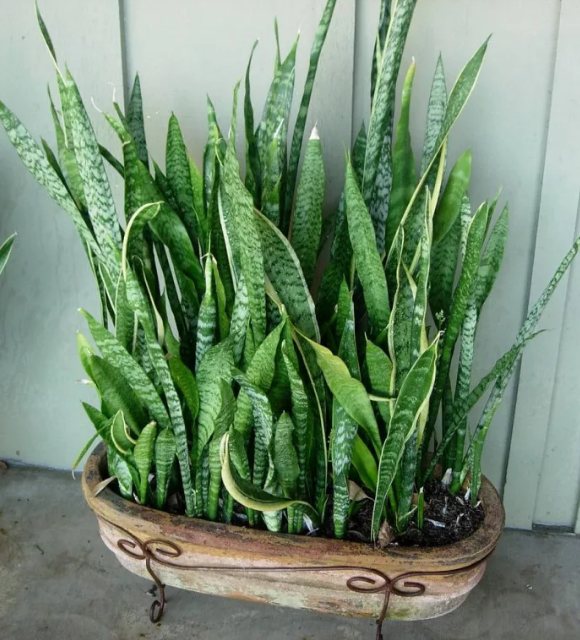

Experts have not yet found confirmation of his heavy energy and "muzhegon" inclinations.
Whether you need a "pike tail" on the windowsill is a personal matter. Experienced growers unanimously say “yes”. The main thing is to observe certain points.



